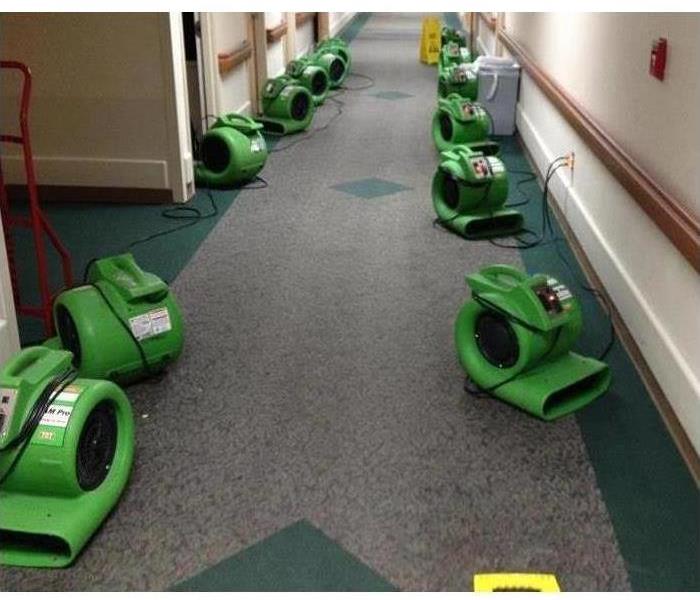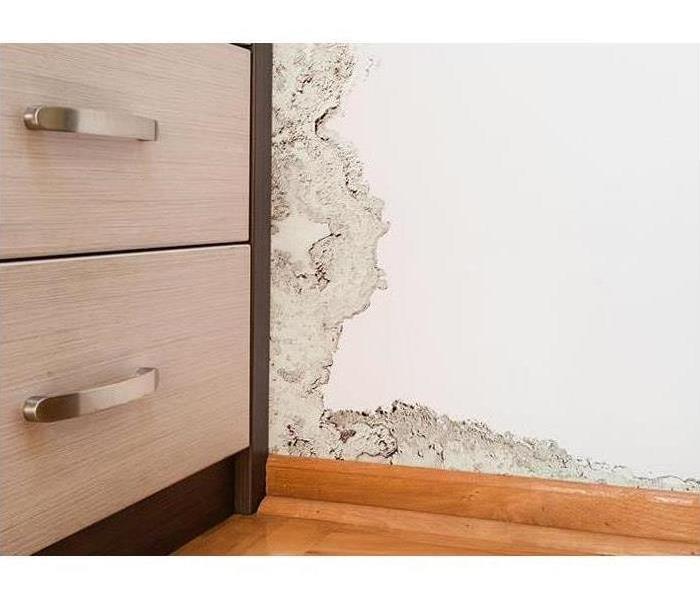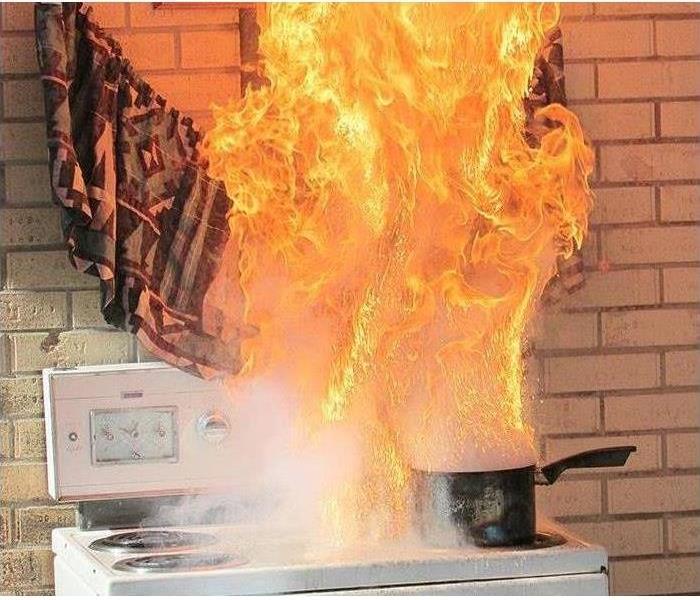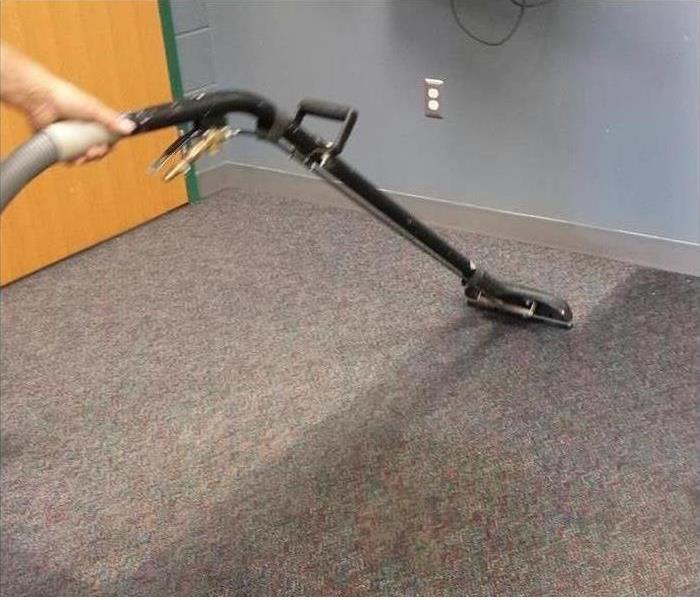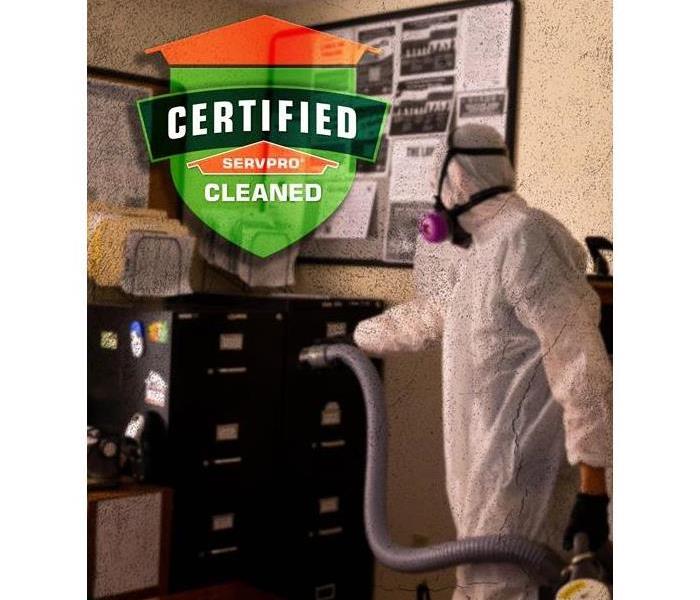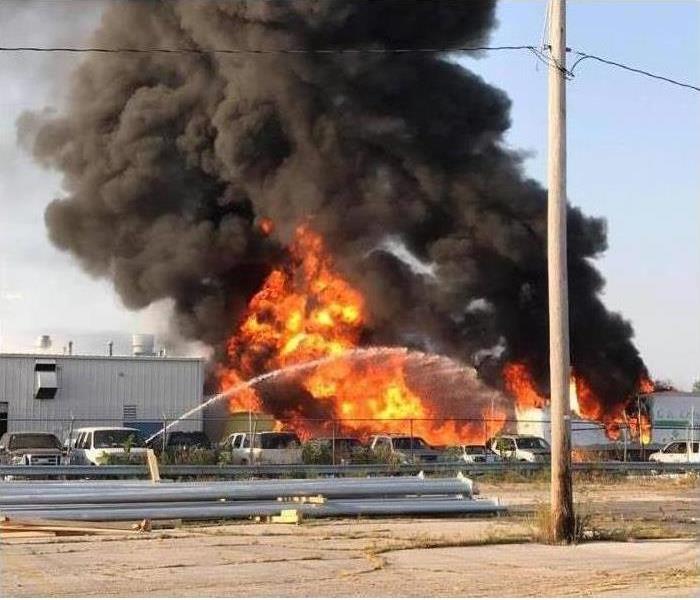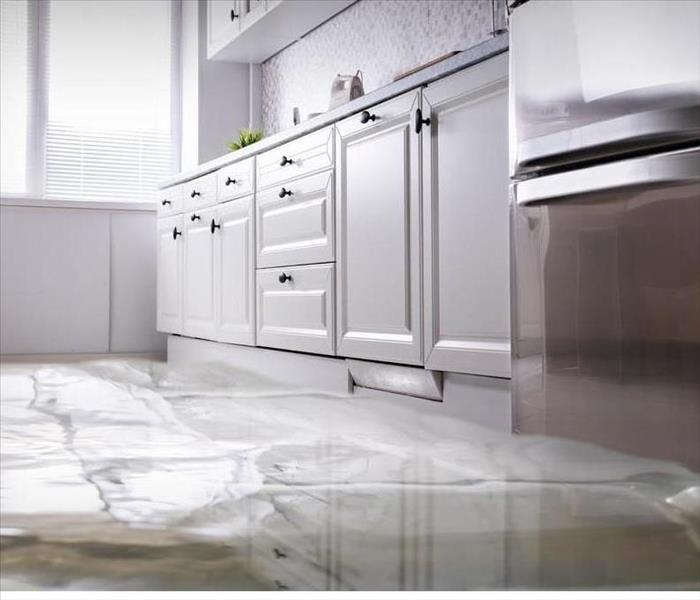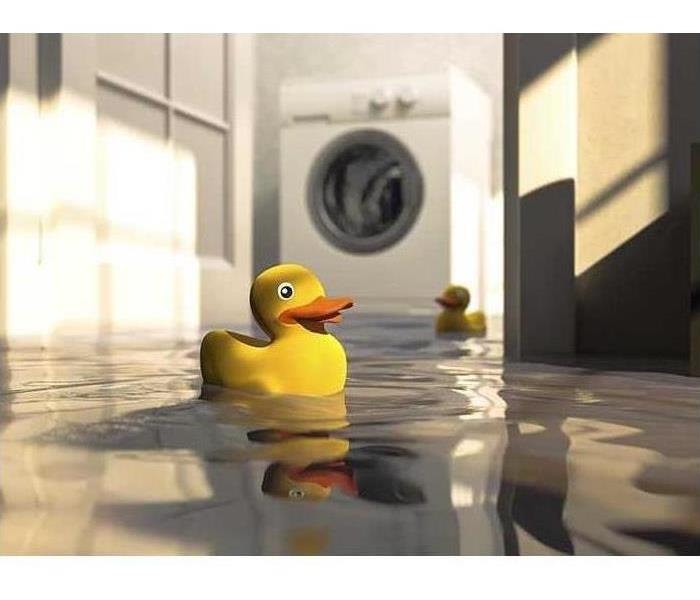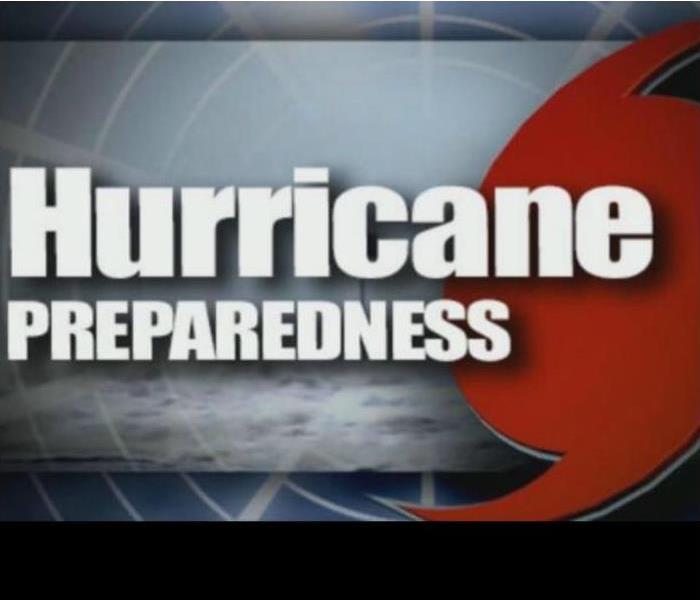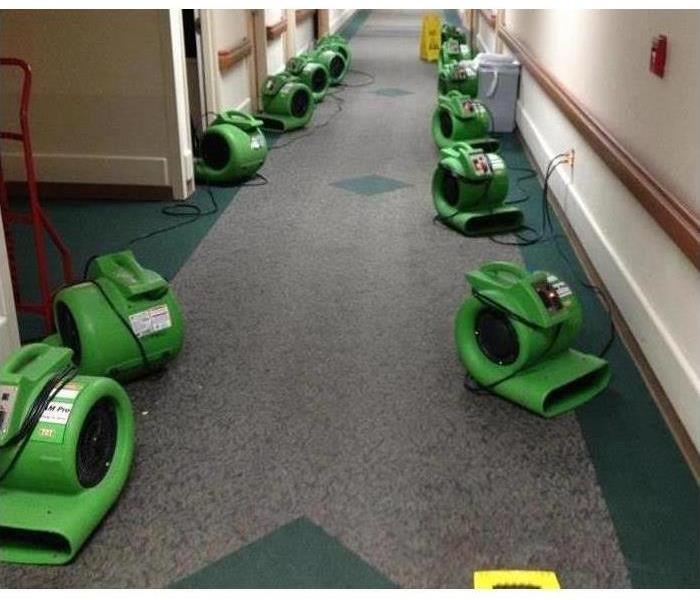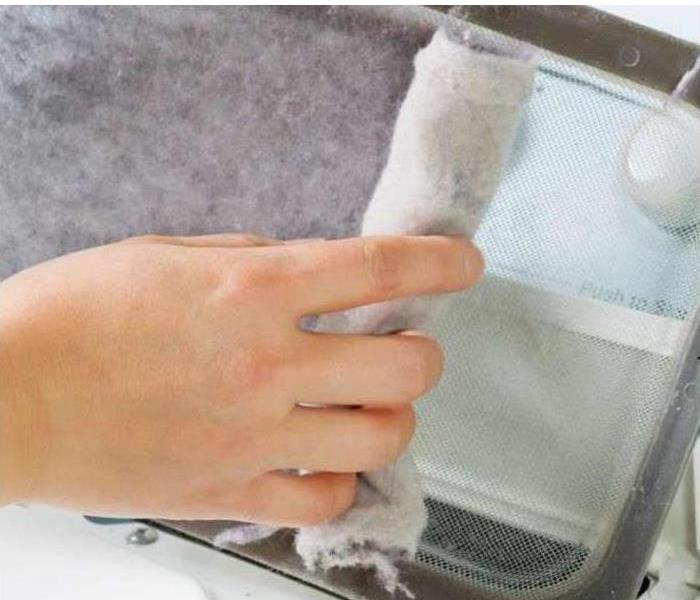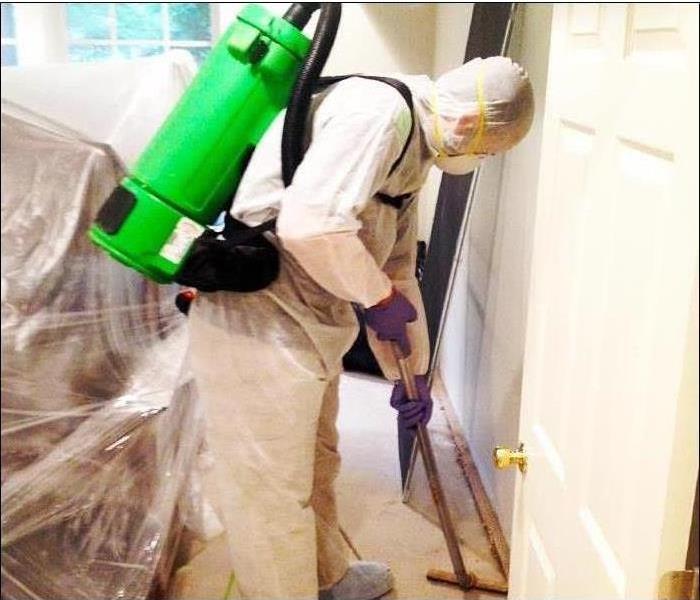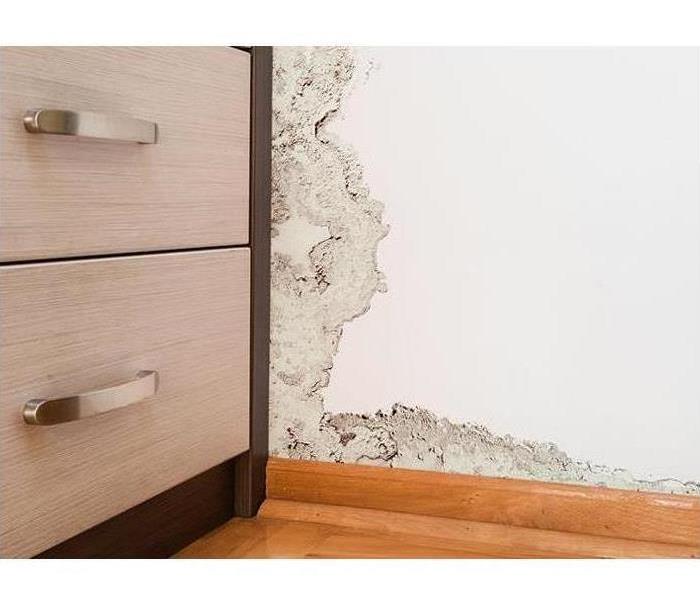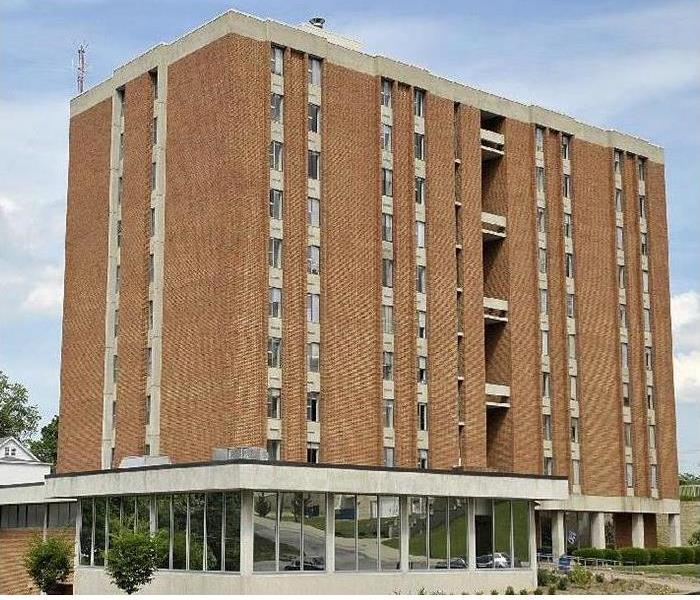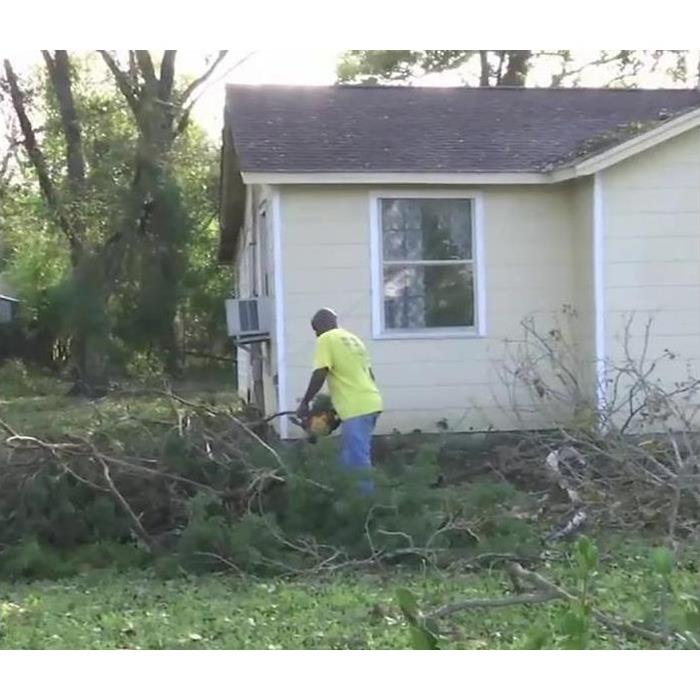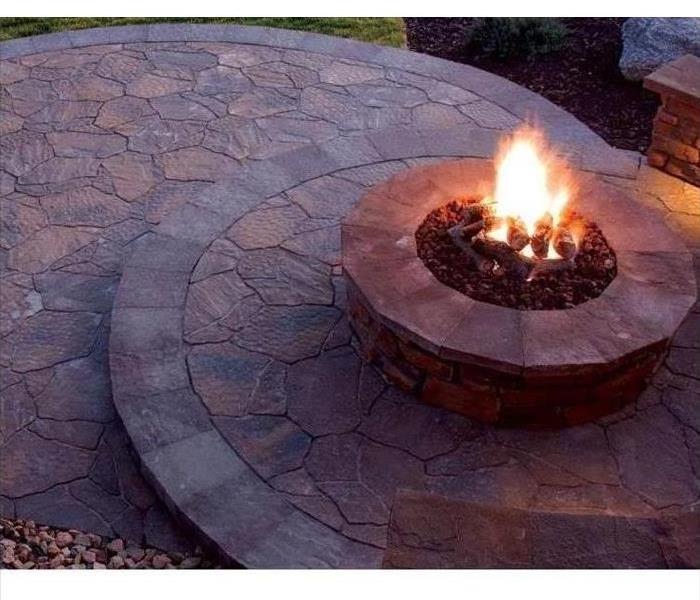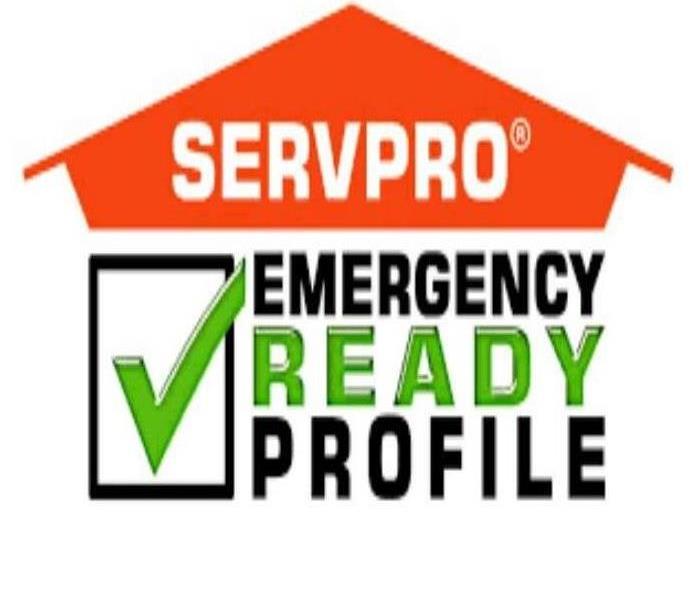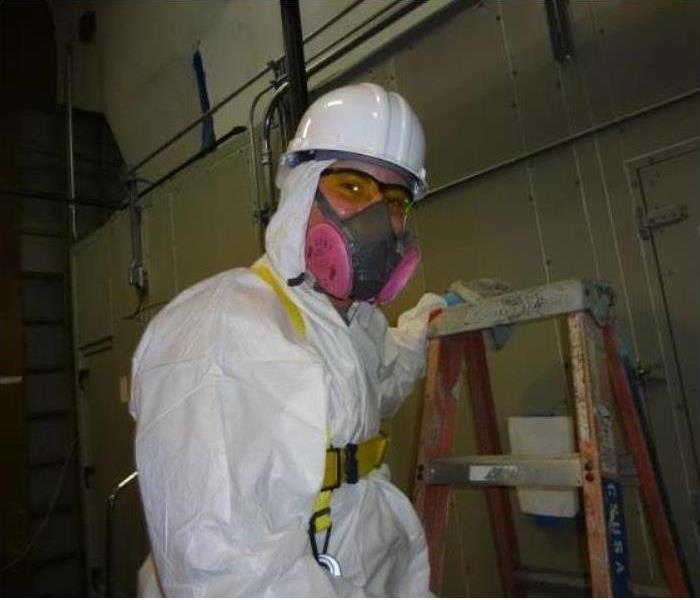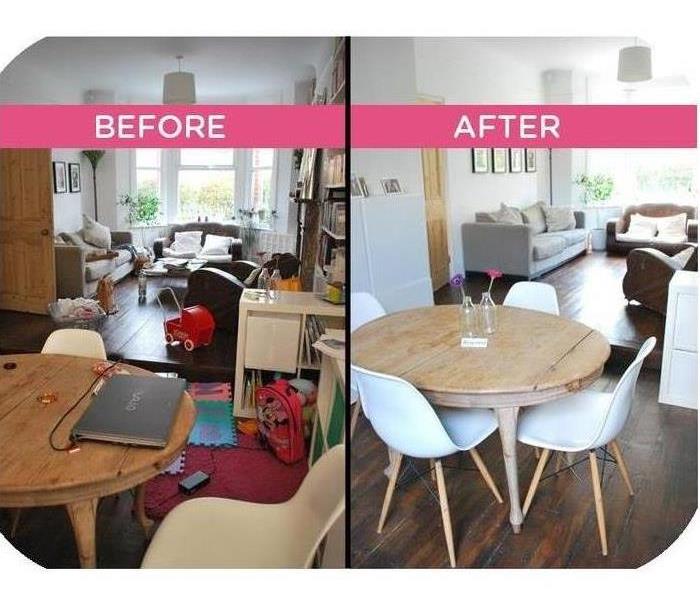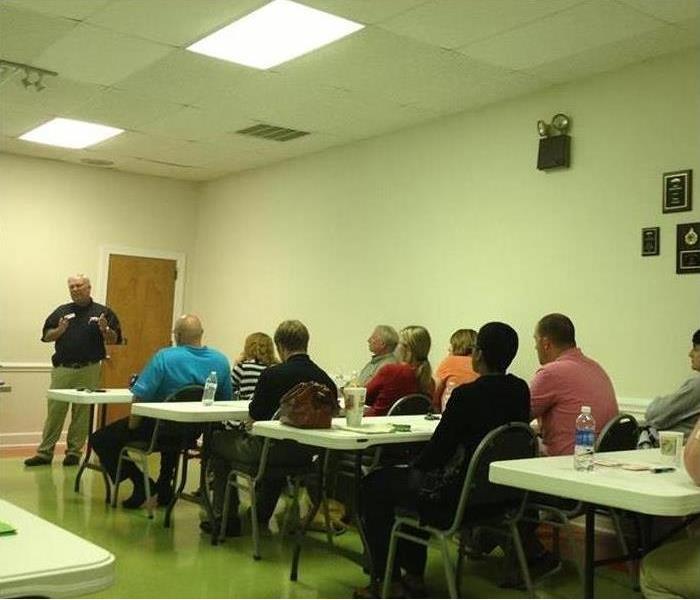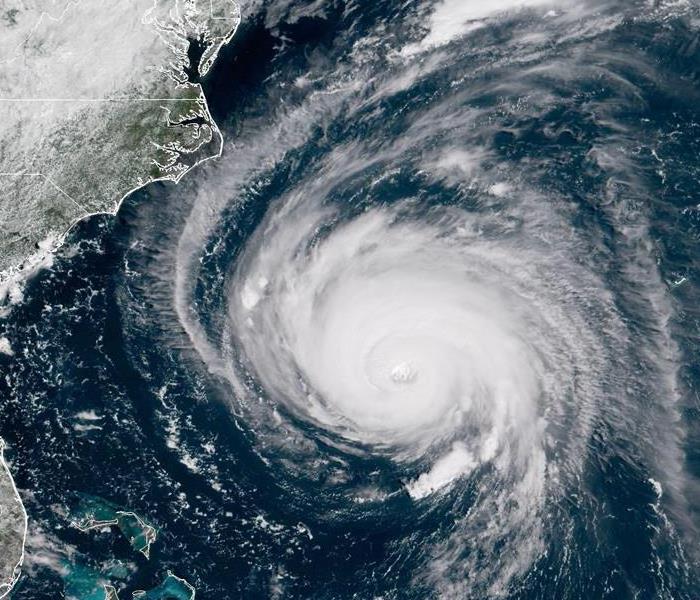Archived Blog Posts
Clothes dryers, lint and what you need to know
3/14/2022 (Permalink)
Firefighters across the country respond to countless home fires caused by clothes dryers. A buildup of lint can cause a fire. In other words, not cleaning your dryer can be more of a threat of fire than an electrical malfunction.
Now, some dryers have indicators designed to alert you when lint has built up or blocked the vent. It is still good practice to check with your own eyes, for lint every time you use your dryer.
Below are three simple steps for laundry-room safety.
Clean The Lint Filter
Not once a month, or even once a week, remove lint from the dryer’s lint screen every time you use your dryer. It doesn’t matter if you do this before or after drying a load, but remove any lint from the screen at some point during each use. Not only does this help prevent a fire, but it also helps your laundry dry faster.
Replace the Accordion-Style Ducts
Most of the time, dryers are equipped with a 4-inch vent in the back, which homeowners or installers connect to the outside vent with a duct. But not all ducts are made the same.
If you have plastic or foil accordion-style duct connecting your dryer to the vent, it's a good idea to replace it.They are risky because they can sag, allowing lint to build up at low points. Also, the ridges on this type of duct can trap lint. Using a metal duct won’t sag, and lint is less likely to accumulate. Try using the shortest length possible.
Inspect Vent and Exhaust Duct Regularly
If you notice that your dryer takes longer than it used to, to dry clothes, that's a clue that there may be a blockage. Another clue is when you’re drying a load, go outside, and look at the dryer vent. Do you see or feel exhaust air? If not, the vent or exhaust duct is probably blocked with lint.
Try disconnecting the duct from the dryer, cleaning it out, and reconnecting the duct to the dryer and outside vent. Also, clean behind your dryer and underneath it because lint can build up there too.
SERVPRO of Lenoir, Duplin & Jones Counties would like for homeowners to use these simple tips to prevent a fire in your home. If you find a build up of lint in your dryer vent upon inspection, we can clean that too! Call 252-208-7888 and schedule an appointment!
Your attic and water damage-is it preventable!
3/14/2022 (Permalink)
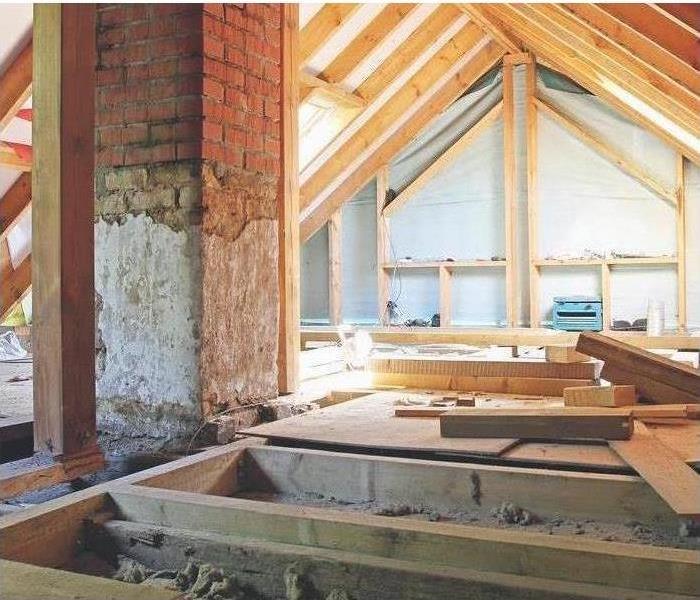 Have you inspected your attic lately?
Have you inspected your attic lately?
Water and moisture in an attic can cause major headaches and costly repairs. Also, mold can grow and contaminate your home's air quality, and water can even weaken its structure. Homeowners need to know what causes the moisture in their attic in order to stop water damage. The damage could come from a leaking roof, faulty insulation and/or ventilation or appliance failures. SERVPRO of Lenoir, Duplin & Jones Counties offer these helpful tips at how to reduce attic water damage:
Look for Leaks in Your Attic-Check the insulation and wood for signs of water damage like mold or discoloration of the wood. Also, check around where the light fixtures are paced from above.
Ventilate Your Attic-Moisture in your attic space increases without the proper ventilation. Good attic ventilation is especially important in winter, because in winter, warm air rises, enters the attic, and then condenses on any cold surfaces of the attic. Condensation can’t be released unless your attic has the proper ventilation. Also, make sure any attic vents are open and not blocked by insulation or clutter.
Insulate Your Attic-The temperature levels in your attic are controlled by the insulation you use. In the winter months, the attic temperature should be five to ten degrees warmer than the outside temperature. The attic floor needs to be properly insulated so warm air from inside your house doesn’t enter the attic.
Vent Appliances to the Outside-A common mistake a lot of homeowners experience is improper ventilation of appliances. The clothes dryer, kitchen vents, and bathroom vents should always blow the air outside of the house and not in the attic.
Maintain Attic Appliances-One other thing to note is that appliances in your attic such as air conditioners, hot water heaters, and HVAC systems may fail and cause water damage. Remember to periodically check these appliances for wear and tear and loose connections.
Storm Damage Clean Up Tips
1/14/2022 (Permalink)
The rain has finally stopped falling and the wind has finally died down. The storm finally may be finally over, but the mess it left behind remains.
Here at SERVPRO of Lenoir, Duplin, & Jones Counties, we want to help your landscape recover after a big storm and have it in tip-top shape again.
Before you head outside to clean up the mess, make sure there are no downed power lines or trees leaning on power lines.
- Inspect trees. After storms pass, your trees may be unsafe–especially if you see large fallen branches, a split tree trunk, or a broken tree top.
- Pick up small twigs, leaves and debris. When all is dry, branches make excellent firewood. As for the leaves, compost them and work them into the soil to improve it.
- Clean up smaller branches. If you have examined your tree, and only a few small branches were damaged, you can likely do it yourself. For branches less than 2” in diameter you should be able be able to reach it from the ground without a ladder. If that’s the case, then grab your tree trimming tools and get busy.
- Fix puddles of water on the lawn. If you often spot a small pool in the yard after storms, you’ve got a problem with water runoff in that area. Or if it’s a larger puddle each time, consider filling in the depression or redirecting the water flow. You could also plant shrubs that love water, so they can help soak up the water in that area.
- Help your trees recover. Throughout the year help keep your trees healthy. Healthy trees are less likely to have deadwood break off during storms.
We at SERVPRO of Lenoir, Duplin, & Jones Counties hope you can use these tips to help make your yard safe again.
Can winter storms affect your roof and cause water damage?
1/13/2022 (Permalink)
Roof damage can occur at any time of year, we know that, but winter weather can be especially harsh on a house’s roof and it’s almost never a good idea to simply wait for spring before addressing the issues that the presence of snow and ice on your roof can cause. In most cases, winter weather won’t cause new damage to your roof, however it can exacerbate existing—or even unknown—problems.
Here we list the most common forms of roof damage that can occur during these cold winter months.
Water Damage
Freezing rain can seriously damage your roof. This is particularly problematic if ice builds up in your gutter and prevents water from draining properly from your roof. Extensive water damage can also occur if your area experiences heavy rain and the accumulated water gets under your shingles and into your home. Even just a few inches of water can cause extensive interior home damage by affecting electrical wiring and causing mold to grow inside the home. Both slanted and flat roofs are susceptible to water damage. To prevent water from getting trapped in your roof, ensure that your roof is properly ventilated. If any minor holes or leaks exist, fix them immediately to prevent water from entering at those points.
Snow Damage
This is especially risky if your home’s roof is flat or designed in such a way that snow cannot easily fall down the sides. Snow may melt fairly quickly thanks to the heat emitting from your home; however, it can enter through cracks in your roof if there is more snow on your roof than your gutters can handle. If your roof is old, heavy snow could lead to structural damage, or even a complete cave-in. If you have damaged or missing shingles, or poor sealing around your chimney, flashing or skylights, melting snow can seep through and reveal potentially devastating leaks. To prevent snow damage to your roof after a particularly heavy snow, you may want to clear the snow using a roof rake.
Wind Damage
Wind damage during the winter is not uncommon. Strong winter winds can damage your roof by loosening your shingles and blowing them off your roof. If shingles or other pieces of your roof have been loosened or blown away by a storm, replace them immediately to preserve the integrity of your roof and avoid damage like trapped water or leaks. Also be sure to trim all tree limbs that are close to the roof, before they get heavy-laden with ice and snow and strong winds can bring them crashing down onto your roof.
Ice Dams and Icicles
Ice dams can result in one of the worst types of roof damage over the winter. If you’re seeing any of these on your home this winter, don’t ignore them! It’s important to note ice dams and large icicles are usually caused by poor insulation or ventilation. Snow and ice melt on your roof due to the internal heat from your house; however, this heat is not evenly distributed across your roof, and melting water that collects in cold areas freezes into a solid mass of ice. These dams can prevent melted water from running off your roof, causing it to pool on the roof, where it can cause leaks. Also, the falling icicles can pull down gutters or other parts of your roof and hanging icicles can be extremely heavy, contributing to rotting. Knocking down the icicles yourself can cause just as much damage as letting them fall, so it’s best just to prevent them from forming by keeping your gutters clean.
If you think you may have suffered water damage from winter storms, call us immediately for an inspection!
Do you clean your dryer? Here is why you should
1/11/2022 (Permalink)
Firefighters across the country respond to countless home fires caused by clothes dryers. A buildup of lint can cause a fire. In other words, not cleaning your dryer can be more of a threat of fire than an electrical malfunction.
Now, some dryers have indicators designed to alert you when lint has built up or blocked the vent. It is still good practice to check with your own eyes, for lint every time you use your dryer.
Below are three simple steps for laundry-room safety.
Clean The Lint Filter
Not once a month, or even once a week, remove lint from the dryer’s lint screen every time you use your dryer. It doesn’t matter if you do this before or after drying a load, but remove any lint from the screen at some point during each use. Not only does this help prevent a fire, but it also helps your laundry dry faster.
Replace the Accordion-Style Ducts
Most of the time, dryers are equipped with a 4-inch vent in the back, which homeowners or installers connect to the outside vent with a duct. But not all ducts are made the same.
If you have plastic or foil accordion-style duct connecting your dryer to the vent, it's a good idea to replace it.They are risky because they can sag, allowing lint to build up at low points. Also, the ridges on this type of duct can trap lint. Using a metal duct won’t sag, and lint is less likely to accumulate. Try using the shortest length possible.
Inspect Vent and Exhaust Duct Regularly
If you notice that your dryer takes longer than it used to, to dry clothes, that's a clue that there may be a blockage. Another clue is when you’re drying a load, go outside, and look at the dryer vent.Do you see or feel exhaust air? If not, the vent or exhaust duct is probably blocked with lint.
Try disconnecting the duct from the dryer, cleaning it out, and reconnecting the duct to the dryer and outside vent. Also, clean behind your dryer and underneath it because lint can build up there too.
SERVPRO of Lenoir, Duplin & Jones Counties would like for homeowners to use these simple tips to prevent a fire in your home.
Restoring your Commercial Property after a loss
1/5/2022 (Permalink)
Flooding and water damage events at Lenoir, Duplin or Jones County commercial properties are often complex with numerous issues that require a knowledgeable and flexible response. Whether we’re dealing with a relatively small water cleanup scenario or a large scale event, we work quickly to assess each unique situation and isolate the damaged area. In many instances, normal operations can continue in a temporary space while we restore your facility.
Restoring Commercial Properties Presents Unique Challenges
Our professionals are trained to be mindful of legal and environmental concerns and strive to fully restore the damaged area while working within your budgetary constraints. We understand that every hour spent cleaning up is an hour of lost revenue and productivity. So when an emergency situation arises in your business, give us a call and we’ll be there fast with the help you need.
SERVPRO of Lenoir, Duplin & Jones Counties specializes in the cleanup and restoration of commercial and residential property after a water damage event. Our staff is highly trained in property damage restoration. From initial and ongoing training at SERVPRO’s corporate training facility to regular IICRC-industry certification, rest assured our staff is equipped with the knowledge to restore your property.
Protecting your business from mold
1/5/2022 (Permalink)
At a business, mold not only has the ability to damage the building, it could possibly cause health issues for your employees and your customers. There are several causes of mold, but mold usually results from excessive water moisture that is never dealt with. Mold thrives in warm, humid, and areas with a a lot of moisture.
When any of the above issues exist, mold can grow. Some types of mold can grow very fast, sometimes within a matter of a couple of days. If mold is not dealt with, it could possibly cause many symptoms of sickness in employees and customers, such as eye irritation, congestion, coughing and skin rashes. In some cases, mold could also cause fever, shortness of breath and infection.
SERVPRO of Lenoir, Duplin and Jones Counties would like to offer a few tips to prevent mold from growing in your place of business.
- Control water and moisture accumulating in your building.
- Never install carpet in excessively high moisture areas such as bathrooms and basements.
- Keep the building properly ventilated at all times.
If a leak is found, make sure it is taken care of as soon as possible and remove any wet materials. Preventing the growth of mold will not only protect your building and business, it will also provide a safer environment for your employees and customers.
Grease fires and what you need to know
11/21/2021 (Permalink)
So, you’ve began to warm up the grease to fry some mouth watering french fries and all of a sudden the phone rings. The grease on the stove starts to overheat and smoke, and before you know it, the fryer catches on fire. What you do next to put out the grease fire is very important, so keep these tips in mind.
- Turn the heat off, but don’t move the container of grease.
- Don't pour water on a grease fire. Water could cause the grease to splash on other kitchen surfaces and possibly spread the flames.
- Put a lid on it. Covering the container will hopefully smother the fire.
- Call 911, if the fire has gotten out of control and get out of the building.
- Don't use flour on a grease fire. Sometimes using baking soda can put out a SMALL grease fire, but flour should never be used.
- Fire extinguisher should be the last resort, due to the risk of contaminating your kitchen.
If you suffer a loss from a kitchen fire, call 252-208-7888 for a free estimate. We will work with your insurance company and adjuster to return you to pre loss condition as quickly as possible!
How does water extraction help prevent secondary damage?
11/20/2021 (Permalink)
After a Lenoir, Duplin or Jones county residence takes on water from a water leak, restoring a dry interior becomes essential to protecting the home's structure and contents from additional harm. Because water quickly evaporates and turns to water vapor, and then, soon after, condense on other surfaces, it is almost impossible to contain lost water.
If your property is holding water where it should be dry, SERVPRO's water extraction team in Kinston can get things dry, check for current damaged areas, and carry out preventative measures that enhance the work we do. Different materials absorb and retain water, as well as exhibit different ways in which exposure to water affects them. The drying rates also differ between various elements. Knowledge of this information helps us determine the best methods to use while working on your home.
Water extraction begins with an assessment of the area which provides us with valuable information about the materials involved and the amount of water we need to remove. Part of our water extraction work includes removing waterlogged sections of carpet and drywall. Sometimes we can restore carpeting, but this depends on several factors.
Removing the moisture that microbes need to grow and destroy materials inside your dwelling, as well as stain clothing and other personal belongings, happens when we remove the water vapor these microorganisms require. Without this extra source of moisture, your home's interior structures and contents remain safe from the effects of microorganisms. Mold damage is not the only type of secondary water damage that homes face when water exists in living areas.
Stained sections of ceilings in levels below where the accident took place can appear later. The stains are not because of mold, but the discoloration happens when minute particles leach through the drywall and paint. Other problems that can affect a ceiling include warping. Warped ceilings can become highly risky, as they can collapse from the weight of any trapped water. SERVPRO knows how to rectify both situations and make your home “Like it never even happened.”
Wooden floors and edging that gets wet can become permanently damaged. SERVPRO knows how to dry such aspects of your home, so existing damage decreases in scope. We use industry-accepted procedures, helping these natural components of your home regain their original look as much as possible.
SERVPRO of Lenoir, Duplin & Jones Counties can help you get your home restored after a disaster involving water with our water extraction experts. Holding IICRC certificates in several different areas, we are prepared to take care of every aspect of your home saturated by the water. Contact us by calling our 24-hour service line number 252-208-7888, 365 days a year.
We ARE the CLEANING EXPERTS
11/15/2021 (Permalink)
During this unprecedented time caused by the global pandemic of coronavirus, this is a reminder to our customers that we are specialists in cleaning services, and we adhere to the highest cleaning and sanitation standards.
Specialized Training
We are prepared to clean and disinfect your home or business, according to protocols set forth by the Centers for Disease Control and Prevention. We have years of experience in dealing with biological contaminants, and we will go beyond the scope of work that regular janitorial staff perform on a daily basis.
The CDC encourages cleaning of high-touch surfaces such as counters, tabletops, doorknobs, light switches, bathroom fixtures, toilets, phones, keyboards, tablets and tables. Other spaces mentioned in the CDC’s guidance for commercial spaces include:
- Kitchen/Food Areas
- Bathrooms
- Schools/Classrooms
- Offices
- Retail Spaces
- Water Fountains
- Shelving/Racks
- Sales Counters
- Carpets and Rugs
- Stair Handrails
- Elevator Cars
- Playground Equipment
- Fitness Equipment
Specialized Products
The CDC recommends usage of a labeled hospital-grade disinfectant with claims against similar pathogens to the coronavirus. Multiple products in the SERVPRO product line carry the EPA-approved emerging pathogens claims. While there is currently no product tested against this particular strain of the coronavirus, we are following all guidelines as provided by the CDC and local authorities.
Call Today for a Proactive Cleaning
If your home or business needs deep cleaning services, call the experts today – 252-208-7888
Fire prevention and your business
11/9/2021 (Permalink)
As cooler temperatures continues throughout the area, business owners and managers try to keep their employees as comfortable as possible. Many people don’t usually associate the spring months with accidents involving fire. It is very important that business owners try to keep fire safety on their minds throughout the year.
SERVPRO of Lenoir, Duplin and Jones Counties would like to offer a few tips to keep your business from becoming another fire statistic.
Equip the building with fire extinguishers. Have them placed strategically in the building and make sure employees know how to use them.
Prepare a Safety Plan. Make sure smoke detectors are checked regularly, inspect the fire extinguishers at least twice a year, and if the business has a sprinkler system be sure to test it also.
Inspect the interior of the building. Make sure that any flammable liquids or items are stored appropriately in their containers so they won’t catch on fire. Examples of these items are paper, building materials, paint, or cloth.
Check the buildings perimeter. You need to make sure there are no materials that could burn quickly, including trash, wood or paper. Also, make sure the buildings landscaping is free of weeds and is maintained regularly.
Follow these tips and keep your business and your employees safe throughout the year.
Prevent Storm Damage with these useful tips
11/9/2021 (Permalink)
Eastern North Carolina is known for its rapidly changing weather — and that can mean severe storms. Help get your home ready with these tips.
***Remove winter's debris from your gutters, drains, and spouts so that heavy rains can flow freely off your roof. Be sure that downspouts are secure and that water is draining well away from your home and not toward your foundation.
***Prune lanky limbs and branches so they don't snap off in a windstorm and land on your home or a power line.
***If your home has a sump pump, test it to make sure it's clean and operable and that the outflow is draining properly. Consider adding a battery-powered backup sump pump to keep the system working if the power goes out. Furthermore, an automatic standby generator can ensure your sump pump and other electrical systems continue to run during power outages.
***When strong winds are forecast, secure patio furniture and other yard items or put them in your garage or a shed so they don't become dangerous projectiles. Know the difference between these weather alerts:
Thunderstorm Watch: Conditions are right for possible thunderstorms in and near the watch area.
Thunderstorm Warning: A thunderstorm has been spotted in the immediate warning area, the danger is imminent.
If you find yourself suffering from storm damage and need assistance, call us at 252-208-7888
What is the process if we have standing water in our home?
11/4/2021 (Permalink)
Imagine waking up in the wee hours of the morning stepping out from your bed onto squishy wet carpet! The toilet had been running for hours. You stop the water source but what do you do next? Call SERVPRO of Lenoir, Duplin & Jones Counties! But what comes next? Here is what to expect-
Step 1: Emergency Contact
Call SERVPRO of Lenoir, Duplin & Jones Counties at 252-208-7888 and we will answer the phone ready to help. SERVPRO of Lenoir, Duplin & Jones Counties have trained professionals to answer your call. Expect to tell them your name, phone number, and address.
Step 2: Inspection
Our technician will arrive onsite to scope the damage by identifying the water source, the type of water, and survey the extent of the water damage.
Step 3: Water Extraction
With the use of water removal equipment such as truck-mounted vacuums or pumps, we quickly remove hundreds or thousands of gallons of water from your property. During this process we also inspect the materials that may need to be removed for proper drying of the structure.
Step 4: Drying and Dehumidification
Our Professionals will use room measurements, temperature, and relative humidity to determine the optimal number of air movers and dehumidifiers to dry your home or business. We’ll carefully monitor the progress using moisture meters until the materials return to acceptable drying goals.
Step 5: Cleaning and Repair
SERVPRO of Lenoir, Duplin & Jones Counties specializes in restoring contents damaged by fire, water, or mold. Our expertise and training can help you save money while preserving precious keepsakes that can’t be replaced. Some of our restoration tools include carpet cleaning, deodorization, and sanitizing treatments.
Step 6: Restoration
Restoration, the final step, is the process of restoring your home or business to its pre-water damage condition. Restoration may involve minor repairs, such as replacing drywall and installing new carpet, or may entail major repairs, such as the reconstruction of various areas or rooms in a home or business.
We will work alongside your insurance company and adjuster to make sure we get your property restored to it's pre loss condition, saving you time and money.
A water loss at your business is our business!
11/3/2021 (Permalink)
When business owners visualize water damage, they often picture a massive storm wiping out power lines, flooding offices, and shutting down businesses for days at a time. It is true that commercial water damage is often the result of floods and water that stems from weather events and storms.
However, many entrepreneurs and business space renters forget that storms and severe weather aren't the only causes of floods and water damage. Here are some of the typical causes of water damage to commercial buildings.
1. Outdated Sprinkler Systems
Some older office and retail buildings still have outdated sprinkler systems that work in conjunction with fire protection systems. While such sprinklers can come in handy during a fire emergency, they can also cause commercial flood damage if they are faulty or in need of replacement. This could easily damage inventory and business assets.
2. Damaged Appliances and Equipment
This cause of commercial flood damage is more common in restaurants and catering facilities, as well as any business that has appliances and equipment that make use of water. If the appliance fails and sends water across your building, especially during late hours when no one is around, you may come back to work and face a water emergency.
3. Busted Pipes and Plumbing
Just like in a residence, if the plumbing system in your workplace fails water damage could be the result.
4. Backed Up Sewer Lines
This is another cause of commercial water damage that often catches business owners by surprise. Should the sewer line to your building back up or become damaged, realize the potential dangers of contaminated Black Water which can cause health effects and ruin products and office furnishings.
If your business has suffered commercial water damage, SERVPRO of Lenoir, Duplin & Jones Counties and we'll get you back up and running again. Call us anytime 24/7 at (252) 208-7888
What should I do after a fire?
10/21/2021 (Permalink)
Have you had a fire in your home? "Devastating" is an understatement when experiencing the chaos of a fire in your home. Not only is it difficult to deal with the loss, but the clean-up can be too! If it is a small isolated fire, getting the area cleaned and repaired should be a priority! The first thing to consider is the ash and smoke damage. These can lead to corrosion, unpleasant odor, and discoloration. Getting ash and smoke cleaned up immediately will prevent any of these from leading to an even larger problem.
Take immediate action by following these steps if you find yourself handling the aftermath of a house fire:
1. Contact your insurance company.
2. Contact your local fire restoration company.
3. Take photographs of the damage.
4. Keep a record of all conversations with your insurance company.
5. Make a list of everything you lost or that was destroyed.
6. Find a place to stay while your restoration company cleans up your property. While a house fire is a difficult experience, it helps to have a game plan in place.
If you are finding yourself overwhelmed, we can help! We will work with you and your insurance company to return your home as quickly as possible to it's preloss condition! Just call 252-205-7888
Getting children prepared for a natural disaster
8/2/2021 (Permalink)
Talk about emergency preparation with your family so that everyone knows what to do. Discussing ahead of time helps reduce fear, particularly for younger children.
Involve your entire family in preparation activities, such as assembling a emergency readiness kit. Children can feel reassured knowing there’s a plan in place.
How to Guide Your Children During a Disaster
Your Child’s Response May Be Shaped By Yours
Feelings of fear are healthy and natural, but in a disaster, your children will be looking to you for clues on how to act:
- If you show alarm, your child may become more scared, seeing your fear as proof that the danger is real.
- If you seem overcome with loss, your child may feel their losses more strongly.
- If you are able to demonstrate that you feel calm and in control, your child may feel more confident and better able to cope.
A Child Who Feels Afraid Is Afraid
Your child may experience the emergency as being bigger than it actually is. Children's fears can be increased by their imagination, and you should take these feelings seriously. Your words and actions can provide reassurance; be sure to present a realistic picture that is both honest and manageable.
How to Help Your Child After a Disaster
What to Expect
Children depend on familiar routines: wake up, eat breakfast, go to school, play with friends. When an emergency interrupts this routine, they may become anxious, confused, or frightened. These feelings may be expressed in a variety of ways: from clinginess to withdrawal; increased shyness to aggressiveness. Your child may return to previously outgrown behaviors such as thumb-sucking or carrying a cuddly toy.
What to Do
When the danger has passed, concentrate on your child's emotional needs by asking what's on his or her mind. Having children participate in your family's recovery activities will help them feel that life will soon return to "normal."
During their recovery, prevent young children from viewing television news reports of the event. The images can be very upsetting, particularly if the child is too young to realize they are watching repeated footage and not a new emergency.
How to prepare your home and family for a fire
9/15/2020 (Permalink)
Most people take active measures to prevent house fires, but not many people have implemented fire preparation techniques. Yet, fire prep is just as important as fire prevention, and in fact may be more so when it comes to protecting your home and loved ones. If you have yet to implement fire safety procedures, it’s time to do so. Below are five things you can do to get started.
5 Steps To Prepare Your Home for a Fire.
- Test your smoke alarms.
- Plan an evacuation route.
- Teach your children what to do in the event of a home fire.
- Devise a communication strategy.
- Practice.
1. Test Your Alarms
Though your smoke alarms should inform you when they’re low on batteries, it doesn’t hurt to check them periodically. Test them once a month, and to err on the side of caution, replace their batteries at least once a year.
2. Plan an Evacuation Route
This should be at the top of your fire preparation list. Identify all possible exits for each room in the home and make sure that each family member is aware of where those exits are. Designate a family meeting spot outside.
3. Teach Your Children
If you have young children, show them what the fire alarm sounds like and advise them on what to do if they hear one. Inform them of evacuation routes as well.
4. Plan a Way To Communicate
Put together an emergency contact list and make sure that all family members know who to contact if they cannot find one another. Have your young children memorize important phone numbers, beginning with 911.
5. Practice
The best way to ensure that all family members know what to do in the event of an emergency is to practice. Host a fire drill every couple of months and devise different scenarios. In doing so, you can increase the odds that everyone knows what to do and how to escape in a real emergency.
Your fire restoration team or local fire department can review your fire preparation plan and provide additional tips for how to improve it. Don’t cut corners when it comes to fire safety and start planning today.
Strom Preparations for Your Commercial Property
9/8/2020 (Permalink)
If you work in an area like Eastern North Carolina that experiences frequent storms, you may be wondering what exterior maintenance steps you can do to help protect your business from the weather. Fortunately, there are a few steps that many experts recommend.
1. Know the Weather in Your Area
One important aspect of storm preparation is to be aware of the weather. Knowing when you can expect a large thunderstorm or snow can allow you to prepare ahead of time. This can help you prevent possible damage.
2. Protect the Building as Needed
Depending on the weather you're expecting, you may choose to protect your building. Several possibilities include boarding over windows, or placing tarps over vulnerable landscaping. You may also choose to contact a local professional for a recommendation on preventive steps you can take.
3. Inspect Your Building Regularly
Another aspect of storm prevention is regular exterior maintenance. Scheduling a regular building inspection can help you find and repair any problem areas before they become vulnerable to a storm.
4. Keep up With Repairs
Keeping your building maintained can help prevent long-term damage. Conducting repairs to any damaged areas you find as quickly as possible can help you stay on top of the building's maintenance needs, and help prevent long-term repair cost.
5. Know Who to Call for Any Repairs
Another important step for storm preparation is to know who to call for repairs. In many cases a water damage restoration team can help with any flooding or water damages that may have occurred.
When preparing for a storm, these exterior maintenance steps may help you protect the building. Know what the weather in your area is going to do so that you can prepare beforehand. Inspect the property regularly, and conduct repairs as soon as a problem area is found. For large repair jobs you may want to contact a professional.
Commercial sprinkler systems and what you need to know
9/8/2020 (Permalink)
The fire sprinklers in commercial properties are vital to the safety and continued operations of businesses. However, while many property owners install these systems and forget about them, sprinkler maintenance is pivotal to the continued protection and viability of these systems. Different elements of your sprinklers should be checked at various intervals throughout the year.
1. Every Week
At least once a week you should check the control valves and the gauges. However, this varies based on sprinkler style. Control valves should be tested on any system, ensuring they are properly sealed, free of blockages and in the open position. Gauges on a deluge, pre-action or dry system should be inspected weekly for normal pressure readings.
2. Every Month
General sprinkler maintenance requires that gauges in a wet pipe or water-based system are inspected at least once per month. Also, alarm valves should be checked externally. Primarily, you are looking for any signs of damage and checking that appropriate pressure is sustained.
3. Change of Seasons
Either four times a year or at the change of every season, you should check the alarm devices and the hydraulic nameplate. The devices should be inspected for any physical defects, and the hydraulic nameplate should remain secured to the riser. Also, make sure that the nameplate is legible.
4. Once Per Year
A plumbing specialist in the area should be called out once per year to inspect the entire system. While you may be performing all the required visual inspections, a specialist will ensure that the mechanics of the system are operating as they should be.
Sprinkler maintenance is essential to the proper functioning of your fire suppressant system. Without adequate inspections, it is possible that your sprinklers will be clogged and fail during a time of crisis. Therefore, perform the visual checks as described, and once per year hire a professional.
Smoke Travels Fast
9/8/2020 (Permalink)
If you experience a fire in your home or building, it’s not only the flames that you need to be concerned about. In some cases, smoke can cause even more damage. The following are a few reasons that smoke cleaning should be performed as soon as possible after a fire.
1. Smoke Travels Further Than Flames
Even if the fire was small or contained to a specific area, there may be smoke damage beyond this point. Smoke travels through the air and carries soot and other contaminants as it does. Because of this, it is important to have smoke cleaning done throughout the building, whether the flames spread far or not.
2. It Can Cause Long-Term Damage
While fire damage is often obvious, smoke damage can be less so. Smoke and soot particles can find their way into small crevices where they can begin to cause problems for your belongings. This is especially true for electronics, as the acidic elements in the smoke can cause the metal and hardware to corrode. If you believe that your computers, televisions or equipment have been affected, do not turn them on until they have been examined to prevent making the damage worse.
3. Odor Can Be Difficult to Remove
It may be fairly easy to remove the visible signs of smoke and fire damage, but the smell can linger for long afterward. Smoke particles can become trapped in the walls, carpeting and porous items, so you should include these in the cleanup process as well. Smoke odor can be stubborn, but a fire restoration company will have professional equipment that should be able to remove it from the air and your belongings.
After a fire, it can be easy to focus on the damage that you can see, but you should be sure to pay attention to that which is less visible as well. Performing smoke cleaning is an important part of the restoration process and should be done thoroughly to return your building to its previous condition.
What to do if your home has been damaged in a storm
9/8/2020 (Permalink)
For many homeowners in Kinston, NC, severe storms can be a hassle. They can cause damage to your house that might take a lot of time and money to repair. In some cases, you might not know how to proceed if your house has been affected. Use the following storm tips to get your home back in top shape more quickly.
1. Contact Your Insurance Company
If you have experienced storm damage to your home, one of the first things that you should do is call your insurance agent. The claims process can be lengthy, so it’s better to get started sooner rather than later. Many policies have a cut-off for filing a claim as well, so if you wait too long, you might be denied.
2. Hire a Restoration Company
Something else that you should do quickly is to hire an emergency cleanup and restoration company to begin repairs on your home. When damage is left to sit, it can become worse. This will make it more difficult, time-consuming and costly to repair.
3. Document the Affected Areas
While you are waiting for your insurance adjuster to arrive, you can begin documenting the storm damage in your home. Check the house thoroughly and write down everything that has been damaged. You can give this list to your adjuster to help with the claims process. You should take pictures of everything since the insurance company will need evidence of the damage.
4. Prevent Damage From Worsening
One of the most important storm tips to remember is mitigation. This step is necessary to keep damage at a minimum. In some cases, if this is not done, your insurance claim can be denied. It can also increase the amount of time needed for repairs. Board up affected areas to keep water from spreading, and move items to a dry location.
After your home has been damaged, it can be difficult to keep your thoughts organized. You might have a lot of concerns and frustrations. However, keeping these storm tips in mind can help you get through the situation more calmly.
What is the process for water damage restoration?
9/3/2020 (Permalink)
Imagine waking up in the wee hours of the morning stepping out from your bed onto squishy wet carpet! The toilet had been running for hours. You stop the water source but what do you do next? Call SERVPRO of Lenoir, Duplin & Jones Counties! But what comes next? Here is what to expect-
Step 1: Emergency Contact
Call SERVPRO of Lenoir, Duplin & Jones Counties at 252-208-7888 and we will answer the phone ready to help. SERVPRO of Lenoir, Duplin & Jones Counties have trained professionals to answer your call. Expect to tell them your name, phone number, and address.
Step 2: Inspection
Our technician will arrive onsite to scope the damage by identifying the water source, the type of water, and survey the extent of the water damage.
Step 3: Water Extraction
With the use of water removal equipment such as truck-mounted vacuums or pumps, we quickly remove hundreds or thousands of gallons of water from your property. During this process we also inspect the materials that may need to be removed for proper drying of the structure.
Step 4: Drying and Dehumidification
Our Professionals will use room measurements, temperature, and relative humidity to determine the optimal number of air movers and dehumidifiers to dry your home or business. We’ll carefully monitor the progress using moisture meters until the materials return to acceptable drying goals.
Step 5: Cleaning and Repair
SERVPRO of Lenoir, Duplin & Jones Counties specializes in restoring contents damaged by fire, water, or mold. Our expertise and training can help you save money while preserving precious keepsakes that can’t be replaced. Some of our restoration tools include carpet cleaning, deodorization, and sanitizing treatments.
Step 6: Restoration
Restoration, the final step, is the process of restoring your home or business to its pre-water damage condition. Restoration may involve minor repairs, such as replacing drywall and installing new carpet, or may entail major repairs, such as the reconstruction of various areas or rooms in a home or business.
Be prepared for 2020 hurricane season
9/1/2020 (Permalink)
Most of the time you know a hurricane is coming.
Tracking its progress as it moves through the Atlantic and Caribbean is almost addicting.
But, that doesn't make a hurricane any less devastating.
Nothing anyone can do will change the strength of a storm, but there is plenty to do to get ready for the after-effects.
Stock Up
People know how long a power outage can last in the wake of a hurricane. Keeping this in mind, its to your advantage, to stock up on necessities before a storm hits.
Don’t wait, plan ahead. Once the storm has done its damage and estimates are given as to how long it will take to restore power, that's when the stores shelves go bare, if they weren't already. You'll want to stock up on: Flashlights & Batteries, Non-perishable food, Candles & Matches, Sanitary water, a 12-volt/Car adapter to charge electronics and a First-Aid Kit.
Research
Other than supplies, it's important to be aware of your surroundings. Do you have an evacuation plan? This is an important question to ask yourself before the storm hits. Having a plan in mind and knowing what to expect may help you stay calm and help keep you and your family safe.
Preparing for no Power
People who are fortunate enough to own a generator, or can help you obtain one, is something to keep in mind. Remember, generators require gas, oil, and power cords to provide electricity for your refrigerator, freezer, lights, and more. Just be sure to never to run a portable generator inside your home, garage, or near open windows or doors. The gas exhaust given off by the generator contains carbon monoxide that can be deadly.
Water damage and your business
8/31/2020 (Permalink)
A lot of commercial business owners understand that water is at many times the enemy especially when it causes them to shut down their business. Water can find its way into almost any space and will use every tiny crack it can to damage the building's structure. No matter how the water got into your business, how a company responds should be the same almost every time. SERVPRO of Lenoir, Duplin & Jones Counties has water technicians on call 24/7 that will respond within an hour of being called and will be at the sight within 8 hours. SERVPRO of Lenoir, Duplin & Jones Counties technicians are well trained to help ensure there are no health threats lingering for employees once all the moisture has been removed from the business.
How safe is your laundry room?
8/31/2020 (Permalink)
Firefighters across the country respond to countless home fires caused by clothes dryers. A buildup of lint can cause a fire. In other words, not cleaning your dryer can be more of a threat of fire than an electrical malfunction.
Now, some dryers have indicators designed to alert you when lint has built up or blocked the vent. It is still good practice to check with your own eyes, for lint every time you use your dryer.
Below are three simple steps for laundry-room safety.
Clean The Lint Filter
Not once a month, or even once a week, remove lint from the dryer’s lint screen every time you use your dryer. It doesn’t matter if you do this before or after drying a load, but remove any lint from the screen at some point during each use. Not only does this help prevent a fire, but it also helps your laundry dry faster.
Replace the Accordion-Style Ducts
Most of the time, dryers are equipped with a 4-inch vent in the back, which homeowners or installers connect to the outside vent with a duct. But not all ducts are made the same.
If you have plastic or foil accordion-style duct connecting your dryer to the vent, it's a good idea to replace it.They are risky because they can sag, allowing lint to build up at low points. Also, the ridges on this type of duct can trap lint. Using a metal duct won’t sag, and lint is less likely to accumulate. Try using the shortest length possible.
Inspect Vent and Exhaust Duct Regularly
If you notice that your dryer takes longer than it used to, to dry clothes, that's a clue that there may be a blockage. Another clue is when you’re drying a load, go outside, and look at the dryer vent.Do you see or feel exhaust air? If not, the vent or exhaust duct is probably blocked with lint.
Try disconnecting the duct from the dryer, cleaning it out, and reconnecting the duct to the dryer and outside vent. Also, clean behind your dryer and underneath it because lint can build up there too.
SERVPRO of Lenoir, Duplin & Jones Counties would like for homeowners to use these simple tips to prevent a fire in your home.
Can mold return after remediation?
8/31/2020 (Permalink)
To be blunt, yes! After obtaining mold remediation services from a certified specialist, along with determining the actual cause of the infestation, the mold problems are usually taken care of. Despite that, it is still possible for mold to return at a later time. The reason usually comes from an underlying moisture problem.
So, why does mold come back after being treated? Mold is a fungus. It contains living organisms that, in order to live, have to breakdown moist, rotting organic matter to survive. Without fungi and other decomposing organisms, dead debris from scraps, leaves, etc. would just simply continue to pile up. In wooded areas, it’s a good thing when mold breaks down wet, rotting wood. In our homes and buildings however, it’s an extremely bad thing.
Mold reproduces by way of microscopic spores, which are almost always present in the air we breathe on a daily basis. Even if your indoor air quality is excellent there are still trace amounts of mold spores present. It’s all but unpreventable. In small masses, fungal spores don’t generally cause any harmful health effects. The last mentioned tends to occur when large amounts of mold are growing nearby, releasing large quantities of spores into the air.
If there’s moisture, especially wet and rotting wood, carpeting, or drywall, it creates the right habitat for molds to begin to grow. Moisture is almost always at the root of mold infiltrations. If the underlying moisture problem isn’t resolved properly during the mold remediation process, the mold problem could very likely recur in the near future.
We here at SERVPRO of Lenoir, Duplin & Jones Counties use highly trained technicians to try and make sure this isn’t the situation at your home or building.
Call us at (252)208-7888 for your mold infestation problems.
Mold and your business
8/26/2020 (Permalink)
At a business, mold not only has the ability to damage the building, it could possibly cause health effects for your employees and your customers. There are several causes of mold, but mold usually results from excessive water moisture that is never dealt with. Mold thrives in warm, humid, and areas with a lot of moisture.
When any of the above issues exist, mold can grow. Some types of mold can grow very fast, sometimes within a matter of a couple of days. If mold is not dealt with, it could possibly cause health effects in your employees.
SERVPRO of Lenoir, Duplin and Jones Counties would like to offer a few tips to prevent mold from growing in your place of business.
- Control water and moisture accumulating in your building.
- Never install carpet in excessively high moisture areas such as bathrooms and basements.
- Keep the building properly ventilated at all times.
If a leak is found, make sure it is taken care of as soon as possible and remove any wet materials. Preventing the growth of mold will not only protect your building and business, it will also provide a safer environment for your employees and customers.
Five ways to prevent mold in your commercial building
8/26/2020 (Permalink)
By possibly eliminating some of the health risks associated with mold and human contact, try following these tips to try and prevent mold from growing inside your commercial building.
- Be observant: Mold can grow in places you may have never thought. Try to be mindful and develop some type of routine to search for any signs of mold or damp surfaces, areas with high moisture or humidity, and in rooms where there may be stains on the wall and have smelly carpet.
- Reduce moisture. The area of the country where your commercial building is located may mean the humidity is always going to be high. Damp air could make it easy for mold to grow in your building. You may wish to have dehumidifiers installed either in basements or attics to help keep areas dry.
- Clean the HVAC: Your building's air conditioning, heating and ventilation system can increase the chances that mold spores are blown throughout the building. By having the HVAC system and ducts cleaned on a regular basis, this may help reduce the transfer of mold spores.
- Repairs: Make repairs and any other issues with the building as soon as they happen, and always try to catch any leaks and water damage before it turns into a moldy mess. Leaky roofs, and unsealed window and door frames are all problems that can cause mold to grow.
- Let the pros handle it: The needs of almost every commercial building are different. So, sometimes to effectively prevent mold from growing, a mold remediation specialist such as SERVPRO of Lenoir, Duplin and Jones Counties may be needed. Our specialists can customize a plan to fit your commercial building. By working with our remediation specialists, we can help you feel confident that any existing mold problems are responded to quickly and hopefully eliminated in the future.
Storms and Your Commercial Property
8/24/2020 (Permalink)
SERVPRO of Lenoir, Duplin, & Jones Counties realizes that summer can bring some pretty crazy storms, but it also brings the risk of storm damage to a commercial building.
Most companies think their property’s appearance is important. When the need arises for emergency or commercial storm damage, most business owners call a professional storm restoration company such as SERVPRO of Lenoir, Duplin & Jones Counties to help.
Storm Damage Facts
Storm damage can extend far beyond just the roof, also, damaging siding, HVAC units and windows. The winds that go along with a storm could cause enough damage to warrant roof repairs or total replacement.
Hail and water damage cause the most damage during a storm. Hail can travel at high speeds, and could cause several dollars' damage to property. Major damage could lead to water leakage into the business and greater structural issues caused by mold.
If you believe the roof may have been damaged in a storm, call trained professionals, such as the crew from SERVPRO of Lenoir, Duplin & Jones Counties. The last thing a company needs is a personal injury on top of your property damage. Our team could rescue your building hopefully from greater structural issues while saving your company time and money.
We’ll help you determine the scope of work needed to mitigate the damage, no matter if it is a partial replacement or a full repair. Determining the scope of work is a crucial step in filing a successful insurance claim.
Getting your commercial property back “Like it never even happened,” is our motto.
Your company has suffered enough hardship. It's your company, you’ve insured it against storm damage, you’ve acquired it, so now is the time to protect it.
Thunderstorms 101
8/19/2020 (Permalink)
What is a thunderstorm?
A thunderstorm is a rain shower during which you hear thunder. Since thunder comes from lightning, all thunderstorms have lightning.
Why do I sometimes hear meteorologists use the word “convection” when talking about thunderstorms?
Usually created by surface heating, convection is upward atmospheric motion that transports whatever is in the air along with it—especially any moisture available in the air. A thunderstorm is the result of convection.
What is a severe thunderstorm?
A thunderstorm is classified as “severe” when it contains one or more of the following: hail one inch or greater, winds gusting in excess of 50 knots (57.5 mph), or a tornado.
How many thunderstorms are there?
Worldwide, there are an estimated 16 million thunderstorms each year, and at any given moment, there are roughly 2,000 thunderstorms in progress. There are about 100,000 thunderstorms each year in the U.S. alone. About 10% of these reach severe levels.
When are thunderstorms most likely?
Thunderstorms are most likely in the spring and summer months and during the afternoon and evening hours, but they can occur year-round and at all hours. Along the Gulf Coast and across the southeastern and western states, most thunderstorms occur during the afternoon. Thunderstorms frequently occur in the late afternoon and at night in the Plains states.
What kinds of damage can thunderstorms cause?
Many hazardous weather events are associated with thunderstorms. Under the right conditions, rainfall from thunderstorms causes flash flooding, killing more people each year than hurricanes, tornadoes or lightning. Lightning is responsible for many fires around the world each year, and causes fatalities. Hail up to the size of softballs damages cars and windows, and kills livestock caught out in the open. Strong (up to more than 120 mph) straight-line winds associated with thunderstorms knock down trees, power lines and mobile homes. Tornadoes (with winds up to about 300 mph) can destroy all but the best-built man-made structures.
Where are severe thunderstorms most common?
The greatest severe weather threat in the U.S. extends from Texas to southern Minnesota. But, no place in the United States is completely safe from the threat of severe weather.
Smoke and Soot Cleanup
8/19/2020 (Permalink)
Smoke and soot are very intrusive and can penetrate various cavities within your home, causing hidden damage and odor. Our smoke damage expertise and experience at SERVPRO of Lenoir, Duplin & Jones Counties allows us to inspect and accurately assess the extent of the damage to develop a plan of action.
Smoke & Soot Facts:
- Hot smoke transfers to cooler areas and upper levels of a building.
- Smoke flows around plumbing systems, seeping through the holes used by pipes to go from floor to floor.
- The type of smoke may vastly affects the restoration process.
Smoke Types
There are two different types of smoke–wet and dry. As a result, there are different types of soot debris after a fire. Before restoration begins, SERVPRO of Lenoir, Duplin and Jones Counties will test the soot to determine which type of smoke damage occurred. The cleaning procedures will then be based on the information determlned during pretesting. Here is some additional information:
Wet Smoke – Plastic and Rubber
- Low heat, smoldering, strong odor, sticky, distorting. Smoke webs are harder to clean.
Dry Smoke – Paper and Wood
- Fast burning, high temperatures, heat rises thus smoke rises.
Protein Fire Residue – Produced by the dissolving of material rather than from a fire
- Virtually invisible, discolors paints and varnishes, extreme strong odor.
SERVPRO of Lenoir, Duplin & Jones Counties Fire Restoration Services
Since each smoke and fire damage situation is a little different, each one requires a unique solution tailored for the specific conditions. We have the equipment, expertise, and experience to restore your fire and smoke damage. We will also treat your family with empathy and respect and your property with care.
Have Questions about Fire, Smoke, or Soot Damage?
Call SERVPRO Today (252)208-7888
We are the CLEANING EXPERTS
7/24/2020 (Permalink)
During this unprecedented time caused by the global pandemic of coronavirus, this is a reminder to our customers that we are specialists in cleaning services, and we adhere to the highest cleaning and sanitation standards.
Specialized Training
We are prepared to clean and disinfect your home or business, according to protocols set forth by the Centers for Disease Control and Prevention. We have years of experience in dealing with biological contaminants, and we will go beyond the scope of work that regular janitorial staff perform on a daily basis.
The CDC encourages cleaning of high-touch surfaces such as counters, tabletops, doorknobs, light switches, bathroom fixtures, toilets, phones, keyboards, tablets and tables. Other spaces mentioned in the CDC’s guidance for commercial spaces include:
- Kitchen/Food Areas
- Bathrooms
- Schools/Classrooms
- Offices
- Retail Spaces
- Water Fountains
- Shelving/Racks
- Sales Counters
- Carpets and Rugs
- Stair Handrails
- Elevator Cars
- Playground Equipment
- Fitness Equipment
Specialized Products
The CDC recommends usage of a labeled hospital-grade disinfectant with claims against similar pathogens to the coronavirus. Multiple products in the SERVPRO product line carry the EPA-approved emerging pathogens claims. While there is currently no product tested against this particular strain of the coronavirus, we are following all guidelines as provided by the CDC and local authorities.
Call Today for a Proactive Cleaning
If your home or business needs deep cleaning services, call the experts today – 252-208-7888
Sewage backups are no laughing matter
7/19/2020 (Permalink)
Indoor floods and plumbing leaks are difficult disasters to handle because they can result in extensive water damage. If the flooding in your home contains sewage or is caused by a sewer backup, the situation will be much more dangerous. Sewage backup contains microorganisms, bacteria, and human waste and those that come into contact with sewage water are at risk for disease or infection. The mess caused by a sewage backup can only be cleaned up by a trained water damage specialist like SERVPRO of Lenoir, Duplin & Jones Counties. Because sewer backups are damaging and hazardous to your health, it is best to know the common signs and causes of a sewage backup so you can prevent them from happening.
Health Effects of Sewage Backups
Flooding in your basement may contain sewage.
The health effects from exposure to sewage can range from illness to more serious diseases and even death. Sewage contamination is responsible for around 2 million cases of illness per year according to the National Resources Defense Council. Sewage water may contain plenty of contaminants and hazardous materials including bacteria, viruses, pesticides, fungus, microorganisms, and others. The following are the most common health conditions caused by bacteria in sewage:
Sewage backups are typically the result of a clogged sewer line which is nearly impossible to spot. However, there are three warning signs of a clogged sewer line that you should look for in your home:
- Backups in several drains: If your sinks, bathtubs, and toilets are experiencing backups and trouble draining, there could be a problem in the sewer line.
- Water backups in strange places: If using one of your plumbing fixtures like the sink or toilet causes backups in a nearby plumbing fixture, this could mean that the water has nowhere to escape.
- Backup in the sewer cleanout: The sewer cleanout is usually a white or black pipe that extends out of the side of your home and it allows access to the sewer line. If the sewer cleanout is full of water, there is a good chance of a sewer line clog.
If a clogged sewer line is the main cause of a sewage backup, then what causes the sewer line to become clogged? The following are the most common causes:
- Blockage from root infiltration: The roots from trees and bushes can infiltrate and damage sewer lines as they extend out in the soil looking for moisture. This infiltration can easily cause a blockage.
- Structural defects: If there is a structural issue with your foundation that affects the sewer line, your sewer line is at risk for a blockage.
- Flushing things down the toilet: Do not flush anything that isn’t supposed to go in the toilet to prevent a clog.
- Blockage in the city sanitary main: Sometimes the city sanitary main line can get clogged and cause backups in nearby homes and buildings through the floor drains.
- Wet weather and flooding in or near your home.
- Broken, blocked, or leaking pipes.
Sewage backups present a major problem in your home because of the potential damage and negative health effects but by recognizing the warning signs and taking preventive actions, you can prevent a sewer backup. If you do experience a sewage backup or in-home flooding that may contain sewage, call us at 252-208-7888 right away. Our professionals are highly trained to deal with sewage water and ensure that it is removed safely.
Fire Pit Safety Tips
3/4/2020 (Permalink)
With more pleasant weather approaching, keep these useful tips in mind-
DO: Build your fire pit on a level surface Make sure the ground or surface is even to reduce the risk of fire escaping beyond your fire pit.
DO: Keep the fire at a safe distance. To keep your fire from causing damage, build the fire pit at least 10 feet from your home, fences, trees and the like.
DON’T: Use gasoline or lighter fluid Never use gasoline or kerosene to start your fire; such fuels can cause a fire to get out of control quickly. Instead, use dry wood as kindling that doesn’t extend beyond the edge of the pit.
DO: Monitor guests around fire pits. Make sure guests maintain a proper distance and don’t exhibit risky behavior. Keep close tabs on children and pets.
DO: Check the weather report
Avoid using your fire pit on windy days, since flames or embers can spread to your home, yard and nearby trees.
DON’T: Leave a fire unattended
Even if your fire pit is small, flames can spread quickly if left unattended. Monitor at all times.
DO: Put your fire out safely
Once you extinguish your fire with water, gently stir and spread the ashes to cool. Leave only when they’re cool to the touch.
DO: Have an emergency plan
Keep a fire extinguisher, garden hose or bucket of sand close to douse the fire in case it gets out of hand. If you can’t put it out quickly, call 9-1-1.
When storms hit hard, we are here to help
3/4/2020 (Permalink)
SERVPRO of Lenoir, Duplin & Jones Counties can provide immediate response and a sense of relief to you and your storm damaged property. As soon as it is safe, we can have a team of our technicians on site.
SERVPRO can help with a number of issues which includes getting emergency food and shelter to you and contacting friends and family.
Storms don’t wait for regular business hours to strike, that's why you need to call the professionals here at SERVPRO who are available to you 24 hours per day, 7 days per week, 365 days per year.
We understand the process of helping you to put your life back together when a storm hits. Allow us here at SERVPRO of Lenoir, Duplin & Jones Counties to show you what several other family members have previously experienced ... our willingness to help make your life normal again.
Call Us Today (252)208-7888
Get your FREE Emergency Ready Profile!
9/12/2019 (Permalink)
The Emergency Ready Profile that we offer at SERVPRO of Lenoir, Duplin & Jones Counties, also known as the ERP (you may have heard us talk about this). Is a FREE service we provide. We will come into your residence or commercial building and provide a file that has all of your emergency contact information including locations of the gas/water shut offs. This profile takes us about an hour to complete including detailed photographs of water shut offs, gas mains, building accessibility and with just a few simple questions we need you to answer including, building contact, maintenance personnel, plumber, HVAC, phone company, etc. This profile is also accessible through your cell phone using a mobile application. IT'S FREE so why not take this opportunity and be ready for any disaster?
It is estimated that up to 50% of businesses that close due to a disaster, such as fire and flood never reopen! Of the businesses that survive, the overwhelming majority of them had a preparedness plan in place. Are you ready for whatever happens? Preparation is a key component for making it through any size disaster, whether it's a small water leak, a large fire, or an area flood. The best time to plan for such events is not when the event happens, but well before it happens. The SERVPRO® Emergency READY Profile serves as a quick reference of important building and contact information or can be an ideal supplement to any well-designed emergency preparedness or existing contingency program. Rather than simply reacting to disaster situations, most prefer proactive measures to establish a relationship with a restoration services company. By working with SERVPRO® of Lenoir, Duplin & Jones Counties to develop your personalized Emergency READY Profile your business will receive the benefit of over 40 years of experience in reducing the impact of any natural or man-made disaster.
SERVPRO® is a leader in water and fire damage response and can help you quickly get your property back in working order. Call us today to get it started 252-208-7888
Addressing Mold in Leases and Purchases of Commercial Buildings
5/28/2019 (Permalink)
Given the increased attention to toxic mold, owners & tenants of commercial buildings and their attorneys are starting to address mold prevention and remediation directly in leases and purchase agreements. And, due to the current lack of scientific knowledge and regulatory uncertainty, the focus should be on risk assessment and prevention of mold problems.
Tenants and purchasers considering a transaction should have an assessment for toxic mold performed by a competent consultant with experience in industrial hygiene, mold sampling and mold remediation. This protocol should become part of their due diligence process. An assessment of indoor air quality for the presence of toxic molds will establish baseline conditions and, if necessary, allow the parties to correct a pre-existing mold problem.
Practices and customs for assessing toxic mold risk and indoor air quality are still developing. Some building owners may develop protocols for regular testing and may provide results to prospective tenants or purchasers. However, most retailers contemplating a lease or purchase transaction will likely have to request permission to perform a toxic mold assessment.
Spring Cleaning Fire Safety Tips
5/27/2019 (Permalink)

With the arrival of spring comes blue skies, blooming flowers and spring cleaning. This is the perfect time for a refresher on fire safety tips that should be followed year-round. Keeping fire safety in mind when doing things around the house will help prevent fires. First and foremost, check your smoke alarms. It’s a task that can easily go forgotten for months, but how convenient that you should change your battery once a year and spring cleaning comes around once a year. Put it on your list of chores for the big clean to ensure that it happens every 12 months. According to the NFPA, a functioning smoke alarm in your home cuts your risk of dying in a house fire by 50 percent. The leading cause of dryer fires is the failure to clean them. Clean the lint filter before and after each load of laundry. Also, be sure to clean the lint that may have collected around the drum and the dryer vent. Keep the are around your dryer clear of things that can burn like boxes, cleaning supplies, and clothing. Check your electrical cords to make sure that they are not running across doorways or under carpets. Extension cords are intended for temporary use. If you are in need of extension cords, have a qualified electrician to install additional receptacle outlets. Clean your garage of stored newspapers or other rubbish that can fuel a fire. Properly store household chemicals in an approved container and never mix cleaning agents. Check and clean filters above stove. Pull refrigerator out and vacuum or dust the coils.
Is your office energy efficient?
5/26/2019 (Permalink)
- Purchase energy-efficient office equipment. Before you buy or lease office electronics, check to see if they are ENERGYSTAR-rated. An ENERGYSTAR-rated appliance has been evaluated and deemed energy-efficient, which can save you money and help you manage your small business energy costs, especially in the long run.
- Reduce Peak Demand. One of the best ways to save electricity in an office is to reduce your peak demand. The phrase “peak demand” refers to the hours in a day when energy usage is at its highest. Peak demand times are typically normal office hours (9 a.m. to 5 p.m.). You can reduce your demand during this time by staggering work hours / start times, running heavy equipment and factory equipment during the evening and early morning hours, and conserving energy throughout the day.
- Program your thermostats. This is one of those office energy saving tips that is especially relevant for a 9-5 workplace. You don’t need to heat or cool a workplace after everyone has gone home for the night. Even if your team’s hours vary, using programmable or smart thermostats to manage the temperature during “off” hours can make a big difference.
- Turn off lights when not in use. It might seem like a no-brainer, but in a typical office, lights stay on in areas like break rooms, bathrooms, or conference rooms, even when those spaces aren’t being used. Sensor lights can help to keep the lights on when needed, but off when they’re not.
- Use energy-efficient light bulbs. It's one of the easiest and simplest energy saving ideas in the workplace: switch out your regular incandescent bulbs with energy-efficient bulbs such as CFL or LED. This will help you use a significantly less amount of electricity.
- Take advantage of natural sunlight. If you’re fortunate enough to have an office space where there’s abundant natural light, use it! On a sunny day, you might not need to turn on the lights at all in areas where windows can give all the illumination you need. While using passive solar heating might not seem like one of the ways to save energy at work, it really does help. The fewer kilowatt hours of energy you use, the less you have to pay.
- Start running fans. You can reduce your energy usage in the workplace simply and easily by running fans in offices, warehouses, showrooms and kitchens. Fans keep air flowing so your HVAC unit can run more efficiently.
- Power down computers and other office equipment at the end of the day. If computers are not being used through the hours when your staff aren’t working, have your team be in the habit of shutting them down before they leave. Turning off and unplugging as many devices as possible at the end of the day is a simple way to cut back. This includes energy efficient coffee makers, toasters, and similar appliances.
- Prevent “Phantom energy”. Phantom energy is the energy that is still being used by equipment that remains plugged in but not in use. A great office energy-saving tip is to have your computer peripherals (printers, monitors, etc.) connected to power strips (aka “surge protectors”) so that the flip of a single switch can shut down several devices at a time.
- Think outside your building. Are you in control of the landscaping around your business? If so, you have a great opportunity to create energy-savings for your small business with energy efficient landscaping. Strategically planting trees to block winds or provide shade on hot summer days can help reduce your heating and cooling costs.
Helpful tips to make your home safer
5/25/2019 (Permalink)
Accidents that happen around people's houses lead to several trips to the emergency room or even death each year. Most injuries at home are preventable when using proper caution.
SERVPRO of Lenoir, Duplin and Jones Counties would like for you to improve safety inside and outside of your home. Here are some tips to make this a priority.
- Improve lighting One of the easiest ways to reduce falls is to improve lighting around the home. Make sure light fixtures are using the highest watt light bulb allowed. Light fixtures are even more important in the fall and winter, when there is not as much natural light. Also, make sure there is enough lighting outdoors by the front door, over the garage, and any other place that is used as a passageway.
- Eliminate slick surfaces Attach nonslip rubber backings on throw rugs and runners. Using bath rugs can reduce slipping on wet surfaces in the bathroom along with nonslip mats used inside bathtubs and showers.
- Declutter all spaces Remove unnecessary furniture and items from rooms to free up more space to walk around. Make sure there are no obstructions near entryways, walkways, stairways and doors.
- Use assistive devices Handrails, grab bars, and nonslip stair treads can make a home safer for people of all ages and physical abilities. Organize closets and cabinets so frequently used items are with easy reach. Step stools can also reduce the risk of injury while reaching for items on high shelves.
SERVPRO of Lenoir, Duplin and Jones Counties hopes that by using these tips, it will help reduce the risk of falling around the home and are very worthwhile home improvement projects most home owners can do themselves.
Continuing Education classes
5/24/2019 (Permalink)
One of the goals at SERVPRO of Lenoir, Duplin and Jones Counties is to help guarantee that our students, as well as ourselves, are all winners at the end of each course.
Our CE Team at Lenoir, Duplin and Jones County continues to strive to offer FREE continuing education classes for insurance agents, insurance adjusters, and real estate agents.
We ask our students and try our best to teach courses that are most interesting to them that also meet their needed continuing education requirements.
For licensees requiring CE, we are continuing to search for new and interesting courses for them to attend, getting the CE credits as promised for attending the courses, and getting their required CE credits in on time for their license renewals.
We get to water damage FASTER
5/23/2019 (Permalink)
- Water and flood emergencies hardly ever wait for regular business hours and neither does SERVPRO of Lenoir, Duplin and Jones Counties. We provide emergency cleaning and restoration services 24 hours a day, 7 days a week—including holidays.
Water damage is very aggressive. Water can swiftly spread throughout your home and could get consumed into your floors, walls, furniture, and more. SERVPRO arrives quickly and begins the water extraction process almost immediately. This quick response helps to minimize the damage and the cleaning and restoration costs.
Water Damage Timetable
Within Minutes
- Water quickly spreads throughout your home, penetrating everything in its path.
- Water is absorbed into walls, floors, upholstery, and your belongings.
- Furniture finishes may run, causing permanent staining on carpets.
- Photographs, books, and other paper goods start to swell and distort.
Hours 1 - 24:
- Drywall begins to bulge and break down.
- Metal surfaces begin to tarnish.
- Furniture begins to swell and crack.
- Dyes and inks from cloth and paper goods spread and stain.
- A moldy odor appears.
48 Hours to 1 Week:
- Mold and mildew may grow and multiply.
- Doors, windows, and studs swell and warp.
- Metal begins to rust and corrode.
- Furniture warps and shows signs of mold.
- Paint begins to blister.
- Wood flooring swells and go out of shape.
- Serious biohazard contamination is possible.
More Than 1 Week:
- Restoration time and cost increase significantly; replacing tainted materials and structural rebuilding may be extensive.
- Structural safety, mold growth, and biohazard contaminants create serious risks to residents.
About SERVPRO of Lenoir, Duplin and Jones Counties
SERVPRO of Lenoir, Duplin and Jones Counties specializes in the cleanup and restoration of residential and commercial property after a fire, smoke or water damage event. Our staff is highly trained in property damage restoration. From initial and ongoing training at SERVPRO’s corporate training facility to regular IICRC-industry certification, rest assured our staff is equipped with the knowledge to restore your property.
Need Emergency Services?
Call Us 24/7 (252) 208-7888
Are you prepared for a hurricane?
5/17/2019 (Permalink)
- So, you’ve began to warm up the grease to fry some mouth watering French fries and all of a sudden the phone rings. The grease on the stove starts to overheat and smoke, and before you know it, the fryer catches on fire. What you do next to put out the grease fire is very important, so keep these tips in mind.
- Turn the heat off, but don’t move the container of grease.
- Don't pour water on a grease fire. Water could cause the grease to splash on other kitchen surfaces and possibly spread the flames.
- Put a lid on it. Covering the container will hopefully smother the fire.
- Call 911, if the fire has gotten out of control and get out of the building.
- Dont use flour on a grease fire. Sometimes using baking soda can put out a SMALL grease fire, but flour should never be used.
- Fire extinguisher should be the last resort, due to the risk of contaminating your kitchen.
Your attic and water damage-It is preventable
4/17/2019 (Permalink)
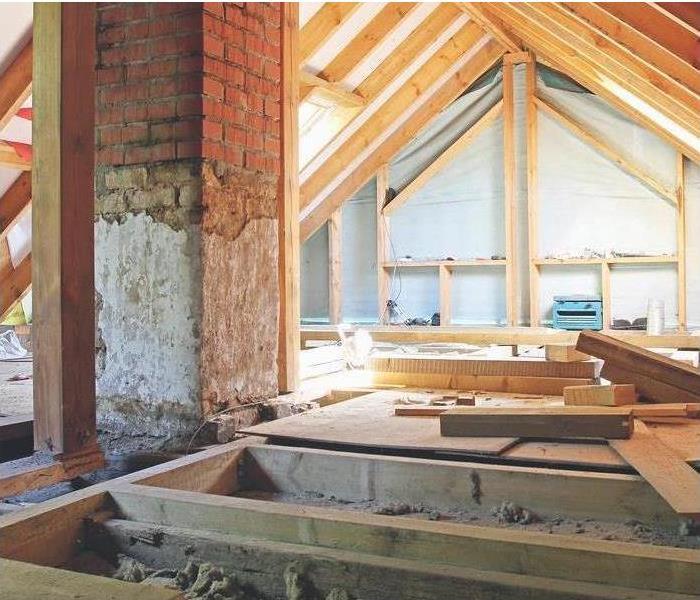 These tips can be useful in the prevention of water damage in your attic
These tips can be useful in the prevention of water damage in your attic
Water and moisture in an attic can cause major headaches and costly repairs. Also, mold can grow and contaminate your home's air quality, and water can even weaken its structure. Homeowners need to know what causes the moisture in their attic in order to stop water damage. The damage could come from a leaking roof, faulty insulation and/or ventilation or appliance failures. SERVPRO of Lenoir, Duplin & Jones Counties offer these helpful tips at how to reduce attic water damage:
Look for Leaks in Your Attic-Check the insulation and wood for signs of water damage like mold or discoloration of the wood. Also, check around where the light fixtures are paced from above.
Ventilate Your Attic-Moisture in your attic space increases without the proper ventilation. Good attic ventilation is especially important in winter, because in winter, warm air rises, enters the attic, and then condenses on any cold surfaces of the attic. Condensation can’t be released unless your attic has the proper ventilation. Also, make sure any attic vents are open and not blocked by insulation or clutter.
Insulate Your Attic-The temperature levels in your attic are controlled by the insulation you use. In the winter months, the attic temperature should be five to ten degrees warmer than the outside temperature. The attic floor needs to be properly insulated so warm air from inside your house doesn’t enter the attic.
Vent Appliances to the Outside-A common mistake a lot of homeowners experience is improper ventilation of appliances. The clothes dryer, kitchen vents, and bathroom vents should always blow the air outside of the house and not in the attic.
Maintain Attic Appliances-One other thing to note is that appliances in your attic such as air conditioners, hot water heaters, and HVAC systems may fail and cause water damage. Remember to periodically check these appliances for wear and tear and loose connections.
Mold? We can handle that!
4/15/2019 (Permalink)
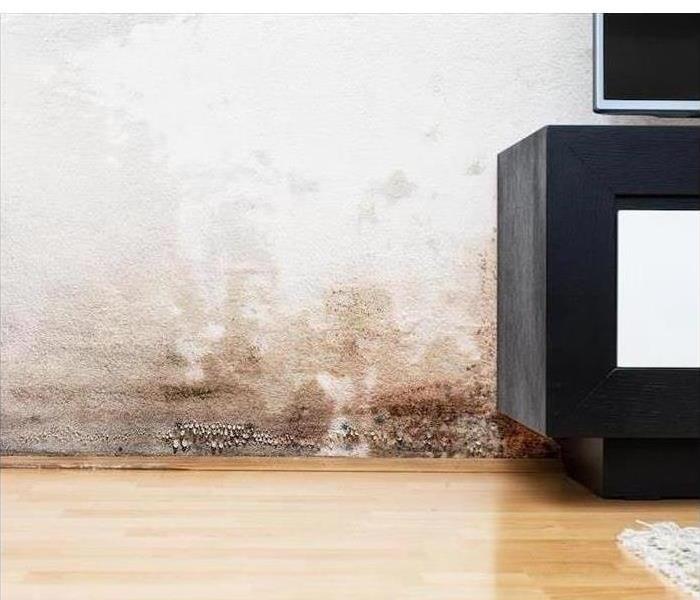 Mold can be a tricky thing but handling it the right way is key
Mold can be a tricky thing but handling it the right way is key
What happens when a mold remediation company, like SERVPRO of Lenoir, Duplin & Jones Counties, shows up at your house to get rid of mold?
Prior to SERVPRO arriving at your house, try and clear out any access items that may be in the way of the remediation zone. Place house pets either in another room or out in the backyard. It helps to move any vehicles from the driveway or garage, and clear a wide path for the technicians to access your residence from the outside all the way to the mold area.
When SERVPRO of Lenoir, Duplin & Jones Counties arrive, they will park as near as possible to the doorway, lay down sheets of plastic, and run hoses through the house to the mold area. If the mold area is accessible from the outside, as in a crawl space, that makes it a lot better. SERVPRO will take care to keep your house clean while they do their work.
Our technicians will then fully suit up for action with head-to-toe white suits, booties, respirators, and goggles. This does not necessarily mean that our technicians will be removing toxic mold. This is common practice for any mold job they are dealing with.
First, a technician will spray the mold area with biocide. Biocide is an EPA-approved liquid which kills mold. You as a homeowner need to note that bleach is not approved by the EPA for killing mold. This part of the remediation process doesn’t take that long.
After the technicians leave, the biocide starts working to kill the mold spores. The next day when the technicians return, they spray the mold area with an encapsulate in order to prevent any mold from growing or spreading.
A day later, SERVPRO of Lenoir, Duplin & Jones Counties returns to spray the area with a type of whitewash paint that encapsulates any remaining mold spores. An area well beyond the moldy area should also be sprayed to ensure that no more mold grows.
Smoke vs Soot
4/15/2019 (Permalink)
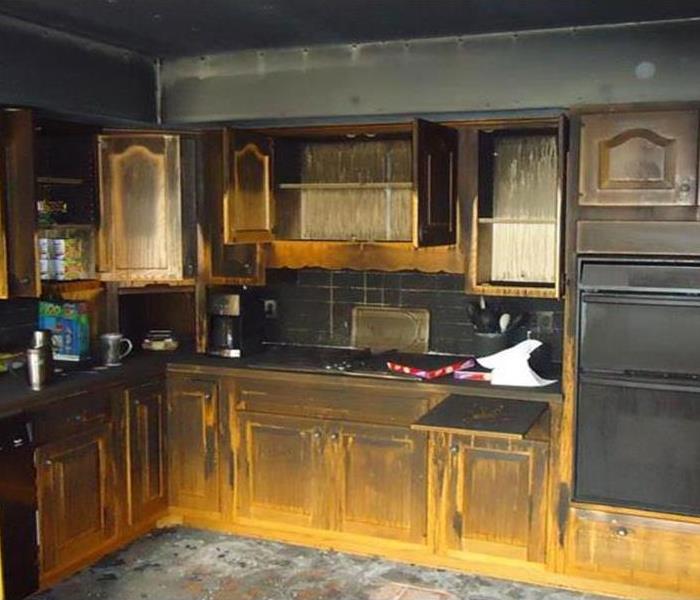 Damage from a fire can be devastating but we are here to help!
Damage from a fire can be devastating but we are here to help!
Smoke and soot are very intrusive and can penetrate various cavities within your home, causing hidden damage and odor. Our smoke damage expertise and experience at SERVPRO of Lenoir, Duplin & Jones Counties allows us to inspect and accurately assess the extent of the damage to develop a plan of action.
Smoke & Soot Facts:
- Hot smoke transfers to cooler areas and upper levels of a building.
- Smoke flows around plumbing systems, seeping through the holes used by pipes to go from floor to floor.
- The type of smoke may vastly affects the restoration process.
Smoke Types
There are two different types of smoke–wet and dry. As a result, there are different types of soot debris after a fire. Before restoration begins, SERVPRO of Lenoir, Duplin and Jones Counties will test the soot to determine which type of smoke damage occurred. The cleaning procedures will then be based on the information determlned during pretesting. Here is some additional information:
Wet Smoke – Plastic and Rubber
- Low heat, smoldering, strong odor, sticky, distorting. Smoke webs are harder to clean.
Dry Smoke – Paper and Wood
- Fast burning, high temperatures, heat rises thus smoke rises.
Protein Fire Residue – Produced by the dissolving of material rather than from a fire
- Virtually invisible, discolors paints and varnishes, extreme strong odor.
SERVPRO of Lenoir, Duplin & Jones Counties Fire Restoration Services
Since each smoke and fire damage situation is a little different, each one requires a unique solution tailored for the specific conditions. We have the equipment, expertise, and experience to restore your fire and smoke damage. We will also treat your family with empathy and respect and your property with care.
Have Questions about Fire, Smoke, or Soot Damage? Call us!
Fire safety tips for your business
4/15/2019 (Permalink)
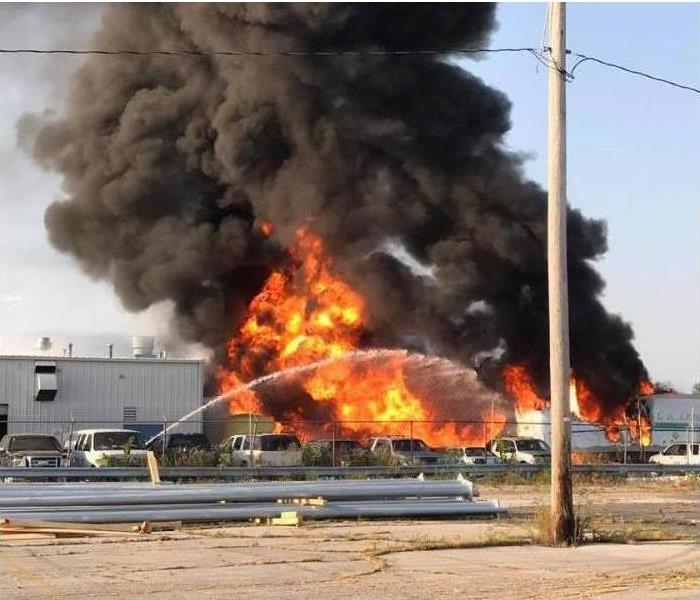 A fire in a commercial building can be devastating to everyone
A fire in a commercial building can be devastating to everyone
As cooler tempatures continues throughout the area, business owners and managers try to keep their employees as comfortable as possible. Many people don’t usually associate the spring months with accidents involving fire. It is very important that business owners try to keep fire safety on their minds throughout the year.
SERVPRO of Lenoir, Duplin and Jones Counties would like to offer a few tips to keep your business from becoming another fire statistic.
Equip the building with fire extinguishers. Have them placed strategically in the building and make sure employees know how to use them.
Prepare a Safety Plan. Make sure smoke detectors are checked regularly, inspect the fire extinguishers at least twice a year, and if the business has a sprinkler system be sure to test it also.
Inspect the interior of the building. Make sure that any flammable liquids or items are stored appropriately in their containers so they won’t catch on fire. Examples of these items are paper, building materials, paint, or cloth.
Check the buildings perimeter. You need to make sure there are no materials that could burn quickly, including trash, wood or paper. Also, make sure the buildings landscaping is free of weeds and is maintained regularly.
Follow these tips and keep your business and your employees safe throughout the year.
Donating to Charities? Read this first
4/15/2019 (Permalink)
As a business owner, you are always being solicited for donations. Here at SERVPRO of Lenoir, Duplin and Jones Counties we are giving a few tips to avoid being scammed when giving donations to charitable organizations.
1. Do not donate through your email account. Scammers can send phishing emails to get your credit card number, debit card number or other personal information.
2. Never donate money in cash. The best way is to pay by check or credit card so you will have access to a history of your transactions. Be cautious of any charities asking for cash donations or to wire them money because you will have no record of the transaction and no way to get back to you if it is a scam.
3. Pay attention to email solicitations. Be cautious of emails that say they have pictures of disaster locations that are email attachments. Those emails could contain viruses, so only open attachments only if you know who the sender is.
4. Pay attention to website addresses. The most reliable charities will end in .org instead of .com. Another red flag is that legitimate charities do not normally solicit donations through money transfer services.
We at SERVPRO of Lenoir, Duplin and Jones Counties want you to understand these valuable tips so your donations get to those who are in desperate need of them.
Mold is OUR business but should not be in yours
4/2/2019 (Permalink)
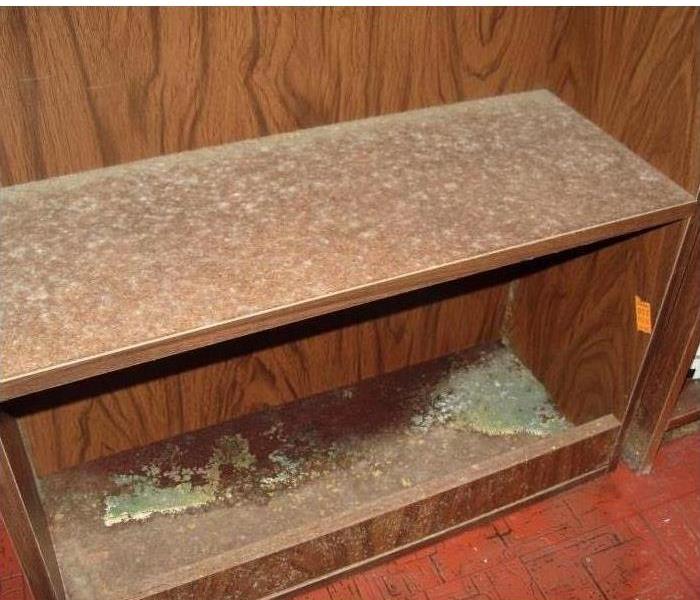 Wood book cases are porous so mold can get inside and spread quickly
Wood book cases are porous so mold can get inside and spread quickly
The fact is, mold is a part of the natural environment. Molds are a type of fungi that can be found almost anywhere, outside or inside, anytime of the year. Just in the United States alone, about 1,000 different species of mold can be found.
Outside, mold can play an important role in nature by breaking down living matter such as fallen trees, leaves that have fallen on the ground, and even dead animals. Medicines and some types of food would have never been developed without the presence of mold.
Indoor mold is a different story. This type of mold should try to be avoided. Problems may arise in a commercial building when mold starts eating away at certain materials. It can affect the way they look, the way they smell, and also the structural quality to buildings framed with wood.
Mold can grow on virtually any surface, as long as moisture, oxygen and an organic source is present in the area. The spores produced by these molds continuously float through the air outside and inside your building.
Excessive moisture in a building should be prevented since mold needs water to grow. Todays buildings are built to be tightly sealed with little ventilation, whereas, buildings built in the 1960's and 1970's were not usually as protected. Other moisture problems may also result from leaky roofs, gutters that allow water to go up under a building, and delaying maintenance issues that may contribute to the buildings moisture problems.
Our professionals at SERVPRO of Lenoir, Duplin & Jones Counties are trained to remediate mold issues in a timely manner should they arise in your commercial building or place of work.
Safety Tips for Deep Frying a Turkey
11/14/2018 (Permalink)
 Be sure to be safe this Thanksgiving
Be sure to be safe this Thanksgiving
With a dark, crispy skin on the outside and juicy, flavorful meat on the inside, deep-frying turkey has become a Thanksgiving favorite. With that in mind, deep-frying a turkey can be dangerous and the process can cause a fire quickly. SERVPRO of Lenoir, Duplin & Jones Counties would like to offer these tips and hope you make safety a priority when deep-frying your turkey this Thanksgiving.
Location, Location, Location
Set the deep fryer on level ground a good distance away from any structure. Don’t put it on a wooden deck or under a tree. The center of a level driveway, away from vehicles is a good location.
Completely Thaw the Turkey in Advance
We’ve all heard that oil and water don’t mix. Make sure the turkey is completely thawed before it goes anywhere near the fryer. If not, when the cold ice hits the hot oil, it could cause the oil to rapidly boil over and cause a large fire.
Keep a Fire Extinguisher Handy
Due to the potential for fire, you will want to have a fire extinguisher close by. A Fire can start and spread quickly, and you probably won’t have time to run inside to retrieve one fast enough.
Easy on the Oil
A easy way to know how much oil you will need is to place the turkey in The empty fryer, then fill the fryer with water. Then take the turkey out and notice the water line. The oil should be filled no higher than that line to make sure that it does not boil over when you add the turkey.
Slowly Place the Turkey in the Oil
Be very careful with the turkey, since it will likely be slippery. If you accidentally drop the turkey in the oil too quickly, the oil could splash or overflow, possibly burning you and creating greater risk for a fire. Lower the turkey in the oil slowly.
Wear Safety Gear
Hot oil Is prone to splatter, causing burns, blisters and ruined clothing. Be sure to wear goggles, gloves and an apron, and don’t any stand closer to the deep-fryer than you need to be.
Use a Thermometer
Using a thermometer throughout the entire cooking process is a good idea. Make sure the oil is hot enough before you begin, but do not allow it to become too hot. Cook the turkey until it reaches the right temperature, remove it from the oil and immediately turn off the fryer.
Mold: Don’t Take the Easy Route
9/5/2018 (Permalink)
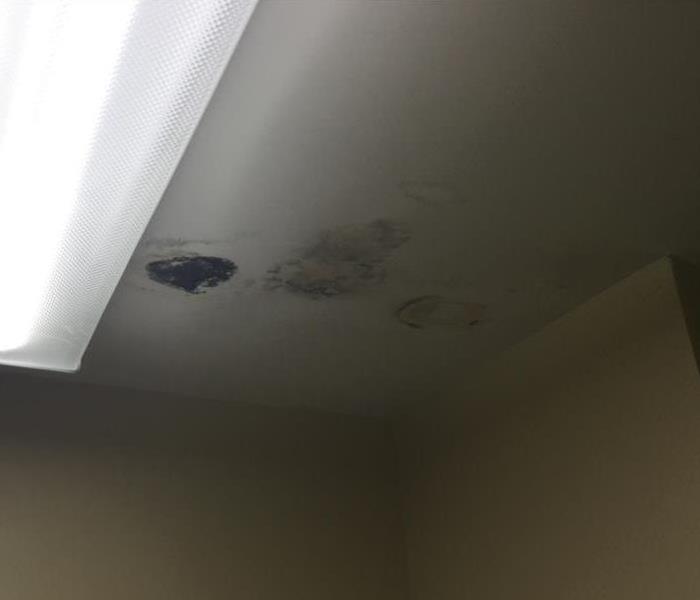 This is an example of how mold can return if it is just wiped down and painted over.
This is an example of how mold can return if it is just wiped down and painted over.
Mold is unattractive, and remediation can be expensive and take up a lot of time. It is because of these reasons that a lot of homeowners and property managers choose to paint over mold. But painting over mold is a bad idea for many reasons. Paint does not kill mold, and it will not stop the source of the mold. Mold will continue to grow under the paint, and you will see apparent signs of mold again. The surface mold that you see on your walls or ceilings is likely only a small portion of the mold problem. The mold may be deep into your walls. Your best bet is to at least perform a professional mold inspection to ensure the mold is identified and the source of the leak is discovered. Once you know the extent of the damage and the origin of moisture has been repaired, you can evaluate your course of action for appropriate mold remediation.
Mold is sometimes called a silent killer. It could impact your health and could cause permanent damage, including death. From itchy skin and headaches to serious respiratory and mental issues, mold could quickly take its toll on your body. The very young and very old are even more vulnerable. You often don’t even know that your health is being affected until the damage has already been done. When it comes to mold in your home or property, take the proper steps to get rid of it. Do not settle on painting over the mold. SERVPRO of Lenoir, Duplin & Jones Counties cares about people’s health and has trained and certified employees that will properly solve your mold issues in a timely healthy manner.
Call SERVPRO of Lenoir, Duplin & Jones Counties at (252)208-7888 for your home or business mold assessment.
Humidity, Mold and Air Quality in Your Eastern NC Home
6/1/2018 (Permalink)
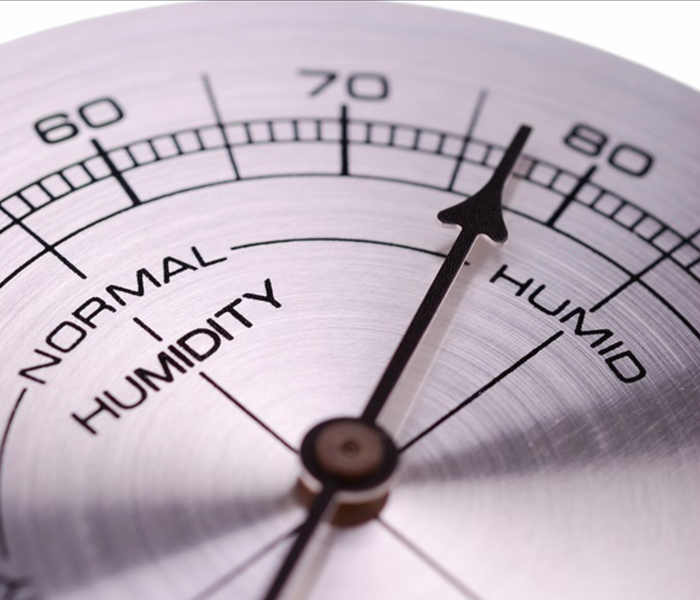 High humidity continues to be an issue during the summer months in Eastern NC.
High humidity continues to be an issue during the summer months in Eastern NC.
We here at SERVPRO of Lenoir, Duplin & Jones Counties want the people of Eastern NC to understand the high humidity issues we all deal with every summer as it relates to our homes.
Air barriers help to control the airflow through and within an enclosed structure. By controlling airflow, moisture is also controlled and therefore lessening the threat of mold in your home.
If moist indoor air comes into contact with a cold surface, it can result in condensation. An air barrier prevents cooler surfaces from being connected with indoor humid air. Warm air can store a lot of moisture, wile cold air stores very little moisture.
When the amount of moisture that can be stored in the air changes from warm to cool, the temperature gets colder. When it’s hot, more moisture is stored in the air, causing high humid levels. But when it’s cold, not much moisture can be stored at all. For those of us in the Lenoir, Duplin & Jones County area, that enjoy grilling out, let’s use this example: if you had a large propane tank filled with gas and you shrunk it, it would eventually spill over. And that’s called condensation.
Back in the day, older buildings would very seldom have condensation problems in cold weather because they were so well ventilated. In other words, they were leaky. The relative humidity in older homes would rarely rise above 25%. As tighter houses have been built, and they have failed to provide mechanical ventilation, the indoor relative humidity has gone up in newer homes.
In tight, heated and unventilated houses, the amount of moisture in the air along with the amount of condensation that can occur are drastically different than in old leaky houses. Condensation can occur wherever water vapor can find a cold spot, such as on roof or on walls, and the inside of window panes, and even inside the walls.
Using another example: if the temperature is 40°F outside and the outdoor relative humidity is 50%, you could allow that outdoor air to enter your home and heat it up to 70°F. The amount of moisture in the air stays exactly the same because the storage capacity of the air increases with the temperature. As a result of this, the relative humidity initially drops. As the moisture is added to the air, the relative humidity rises, and the moisture content rises also. How is moisture added to the air? As you breathe, sweat, boil water, take hot showers and grow houseplants indoors, all of those activities generate moisture in you home.
Indoor humidity becomes a problem when air leaks out of a house through holes in the structure. As the air reaches surfaces colder than 52°F or 53°F, the air will cool. When the air reaches its maximum capacity to store moisture, condensation will occur with the threat of mold beginning not far behind.
If the outdoor air temperature is around 30°F, the indoor air will drop the moisture that it gained on the way out. Since condensation in the walls can cause puddles, and in some cases, rot the structures framing. Condensation is something homeowners should want to avoid. If an air barrier is installed, it can help prevent condensation. Your air conditioning could also cause condensation.The same scenario can happen in reverse during the summer months. For example: if the outdoor air is 85°F and the relative humidity is 75%, the outdoor air leaking inward comes into contact with a surface below about 76°F, then the moisture in the air will condense and in some cases, also causing mold. If an exhaust fan is in your home, the air leaking in could cause condensation issues on air-conditioned surfaces, such as on the back side of vinyl wallpaper.
If moist air enters into a leaky house through gaps in the roof or wall, you may experience problems. But in a tight house with good air barriers along with a supply-only ventilation system, most of the air that’s enters inside the house is drawn in through the air conditioner, so the first cold surface it comes into contact with is the cooling coils of the air conditioner.
If air leaks are present in your building, you usually can’t see the condensation. However, condensation is sometimes visible in the attic space. The only thing a homeowner has to do is look for frost, dampness forming, or any sign of mold on the underside of the roof sheathing.
Not much of a hole in the ceiling of a humid house is needed for condensation to accumulate in the form of frost. Later, as the sun warms the roof up, the frost will melt, the water falls and then you could have have a leaky roof on your hands. Some homeowners would then call a roofer, he puts on a new roof, and it doesn’t fix anything because that was not the problem to begin with . It was an air leak.
If you as a homeowner are experiencing any of these issue, call the professionals at SERVPRO of Lenoir, Duplin & Jones Counties @ (252)208-7888. We are faster to any disaster and will make it like it never even happened.
Mold at School...Not a good Thing
3/13/2018 (Permalink)
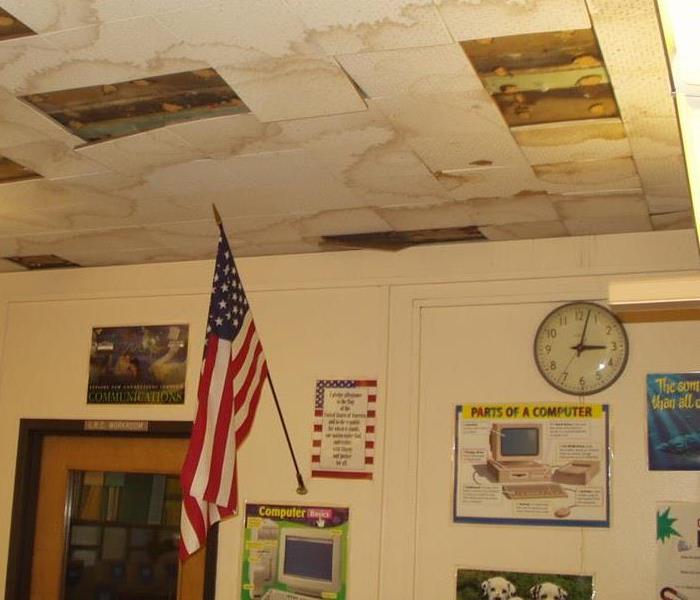 Clearly mold in a school setting is not a good environment for any child.
Clearly mold in a school setting is not a good environment for any child.
- SERVPRO of Lenoir, Duplin & Jones Counties is committed to helping keep our schools free of any mold situations that could be harmful to your kids health. A damp, moldy school environment could be harmful to kids for a several reasons. Damp indoor environments could create conditions that are more favorable for standing water. In schools this can increase pest infestations, all of which could release allergens into the air. Moisture also can cause building materials to release toxins into the air that could cause physical and/or mental health issues. Damp environments may lead to growth of different kinds of molds indoors. Although some molds could be anywhere at any time, indoors or out, including in schools. When wet conditions exist, molds could grow to higher than normally occurring levels. Some schools may be in poor repair and poorly maintained. Many schools could have plumbing problems, leaky roofs or poor ventilation systems, which could create the ideal moisture conditions needed for molds to grow. Moisture and mold problems can be present in schools regardless of the climate or time of year, and may be present in older buildings as well as new construction. Delaying repairs or cutting back maintenance could make the mold problems worse. Many schools have mold problems because of poor construction, or because they are so tightly sealed and poorly ventilated, which prevents most of the moisture from escaping. School personnel and parents should be alert to and help monitor schools for moisture, water damage, and resulting mold problems. We all love an care for our kids and SERVPRO of Lenoir, Duplin & Jones Counties is no different.
How Safe is your Commercial Building?
3/12/2018 (Permalink)
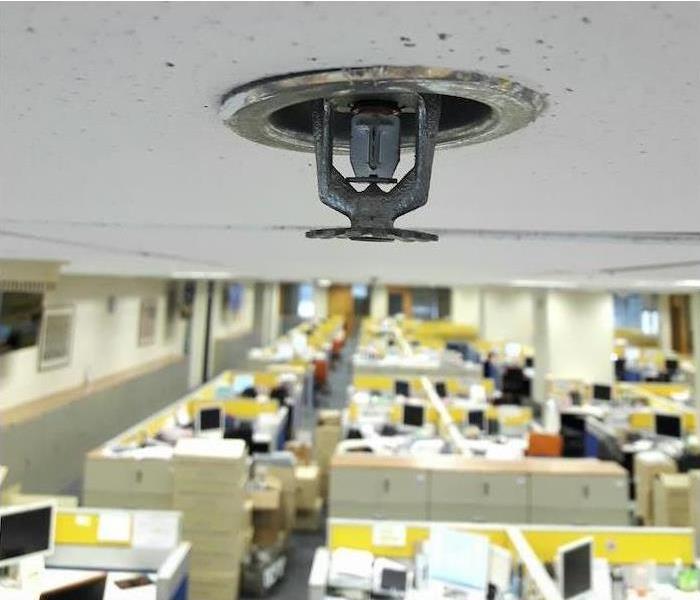 Sprinklers are required for most commercial businesses.
Sprinklers are required for most commercial businesses.
Fire safety should be one of the main concerns of all commercial business owners. If a fire were to occur during business hours it could lead to serious injuries or even death of its employees. No business owner should want that on their hands. Fire sprinklers could be the difference between life and death.
Here are some of the sprinkler requirements for commercial building systems:
- Buildings more than 55 feet in height must have an automatic sprinkler system running throughout the building.
Buildings with a fire area exceeding 5,000 square feet, older buildings that have been remodeled or renovated, or any single tenant add-on that requires a new certificate of occupancy that increases the square footage over 12,000 feet must have fire sprinkler systems installed throughout the entire building.
Fire pumps should be installed to increase the water pressure in a single sprinkler system if that sprinkler system is fed by a non-pressurized water tank. Also, municipal water sources do not provide enough pressurized water to sprinkler systems, resulting in an ineffective system.
Water supply control valves should be accessible for easy operation. All of the valves should be clearly marked with exterior signs showing where the each valve is located. These valves should be marked with information indicating the areas and locations covered by their water source.
These are justa few of the sprinkler requirements needed to keep commercial buildings, workers, and clients safe. So, how safe is your building?
Why Mold Should be Prevented in Commercial Buildings
2/9/2018 (Permalink)
 By preventing mold exposure in your workplace, hopefully you will have less worries of having to go to a Doctor.
By preventing mold exposure in your workplace, hopefully you will have less worries of having to go to a Doctor.
Coming into contact to indoor mold in a commercial building could possibly cause a variety of health problems. In some instances, the ones who could be affected the most by mold and mold spores are usually people who could already have weakened immune systems. People who are not as sensitive to mold related symptoms could also develop health issues due to mold exposure that they didn't even know existed in their building.
People who work or live in moldy conditions could possibly start out with only minor symptoms. If a person were to continue to be exposed mold or the exposure intensifies, their reactions could possibly worsen.
At SERVPRO of Lenoir, Duplin and Jones Counties, our trained technicians will do their best to eliminate any and all mold issues so you and your coworkers can get back to work without the worry of mold lurking.
Drive Safe During Icy Road Conditions
1/5/2018 (Permalink)
 Be very careful when driving in adverse winter weather conditions.
Be very careful when driving in adverse winter weather conditions.
Usaully, when snow is melting, it’s a good thing. But, if melted snow covers roads and freezes overnight, it can make for hazardous driving conditions.
Here are a few tips for driving on icy roads.
Slow down. Driving too fast for the road conditions is one of the main causes of snow accidents.
Space out. Leave plenty of space between your vehicle and the vehicle in front of you. It can take a driver twice as long to stop their vehicle when driving in snowy conditions as to normal road conditions.
Don't slam on the brakes. When you’re driving and start sliding on a patch of ice, slamming the brakes harder won’t stop you vehicle. Probably the best thing a driver can do is go against your normal instincts and turn into the skid. You also need to press the accelerator.
Don't drive at all. If at all possible, avoid driving. When the roads are covered with snow or ice, that’s probably the safest thing to do anyway.
Turkey is Good All Year Long
12/1/2017 (Permalink)
 Turkey meat can be used in many various ways any time of year.
Turkey meat can be used in many various ways any time of year.
After Thanksgiving many people never think about eating turkey until the next year. Turkey is a lot more than a holiday tradition. Anyone who is health conscious would be wise to learn more about the health benefits of turkey and find ways to include in their meals throughout the year.
Turkey is low in fat and high in protein. One piece of turkey breast without the skin has around 160 calories, only four grams of fat and 30 grams of protein. Dark meat can be a little higher in calories but has about the same amount of protein.
Turkey meat contains vitamin B3, which may help increase HDL colesterol, or as what many people refer to as the “good “ cholesterol. It may even help with arthritis inflammation.
Turkey is a very flexible. It can be baked, grilled, boiled, stir-fried, sliced for sandwiches and even chopped for salads. Turkey is good when eaten for breakfast, lunch or dinner. Also, turkey can be substituted for almost any meat in a recipe as it seems to take on the flavor of other ingredients.
So, enjoy turkey throughout the year instead of just at Thanksgiving.
Be Smart This Black Friday
11/22/2017 (Permalink)
 Why would anyone want to stand in long lines when they don’t have to?
Why would anyone want to stand in long lines when they don’t have to?
It’s that time of year again. The deals should be better than ever with most store shelves stocked. So, how do you stay a step ahead of the madness? But, never fear, here are a few tips to try and be a smart shopper.
- Watch for early deals. Many stores start Black Friday a few days early, so keep an eye out for deals. Get it before it’s gone.
- Watch for scams. Since this is a popular time of year it’s important that you be very careful when shopping on the internet.
- Watch the wallet. Just because something is on sale doesn’t necessarily mean you need it. Make a list and stick to it. You can buy for everyone on your list without going overboard.
- Watch from home. Unless you really like standing in long lines in the wee hours of the morning, why not shop from the comfort of your favorite chair? Get that cup of coffee, watch the winter birds outside your window, and grab your laptop to let your fingers do the shopping. Not only will you avoid the long lines but you can shop as long as you want just by clicking a button.
Distress for the Holidays
11/20/2017 (Permalink)
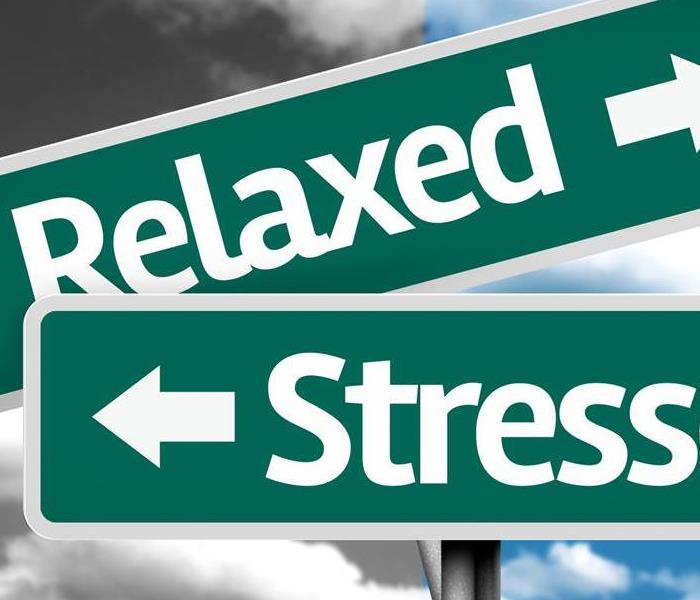 Which direction will you choose this holiday season?
Which direction will you choose this holiday season?
While there may ba a lot of food, laughter, and shopping the next few months, there’s is also a lot of stress to deal with. Here’s a few tips to help:
- Pick & choose. For those activities that are just too difficult or don’t bring joy, just say “No thank you”.
- Dont feel guilty. When saying “no” in a nice kind way, you’re showing yourself respect and sending a message to those around you that you value your time and energy.
- If necessary, leave. Even though you can’t change your family, you can change the amount of time you spend with them by taking a break or leaving. You can just tell them you have something to do, without making a scene.
- Mark your calendar with yeses. RSVP as soon as possible the annual holiday invitations you enjoy, but also look for opportunities to try something new.
Slow down. This may seem almost impossible to some, people need to take time to enjoy the simple things this time of year: place tree ornaments carefully and remember the story behind them, really take in the smells of the holidays and enjoy that cup of hot chocolate.
Whether you are alone or with family and friends, take some time just for yourself. Simply go for a walk outdoors or sit out in the warm sunshine.
How to Cope With Fewer Hours of Daylight
11/10/2017 (Permalink)
 Pay attention to the signs and avoid the winter blues
Pay attention to the signs and avoid the winter blues
- Daylight saving time ends each Fall, at a time when sunlight hours are already declining.
Much of North America isn’t affected as much as countries further up north, but it’s still enough to make us feel a little down.
Here are a few ways to cope with darkness and see it in a different light.
- Be aware of SAD, Seasonal affective disorder is a type of depression that’s actually related to the change in seasons, beginning and ending about the same time each year. Symptoms usually start in the fall and continuing into the winter months. It may reduce a persons energy and make them fell really moody. SAD can get worse and lead to severe problems if it’s not dealt with.
- Make daytime count. Spend more time outside when the sun is bright. When at lunch, sit by a window where the sun is shining in or talk a walk after eating.
- Socialize more. Instead of being cooped up indoors alone, go to spots where local people gather indoors, like coffee houses, resturants or shopping malls. Just being with friends and family can get rid of the winter blues.
Exercise more. Using the darkness can be an excuse to excercise in a gym of fitness center, even if all you do is walk. Physical activies can relieve anxiety and depression, thus improving ones mood.
If a person developes the right attitude, the darkness of fall and winter may not send a person into the doldrums.
Suggestions for a Better Nights Sleep
10/6/2017 (Permalink)
 Sticking to a good sleep routine may improve how you feel everyday.
Sticking to a good sleep routine may improve how you feel everyday.
Getting a good nights rest is very important and many people just aren't getting enough rest. SERVPRO of Lenoir, Duplin and Jones Counties would like to offer these simple tips to get that rest we all need. It takes planned efforts on the part of adults who are falling short of seven hours of sleep each night. The following are some simple ways for adults to start getting more rest.
- Stick to the same routine seven nights a week. Most people tend to change their sleep patterns depending on what day of the week it is. Not many people can say they go to bed early and wake up early on weekends. Going to bed the same time each day, including weekends, can help us feel more sleepy at bedtime and fall asleep quicker.
- Avoid alcohol in the hours before going to bed. Alcohol can make people feel sleepy, but not for long. That sleepy feeling wears off quickly causing interrupted sleep.
- Avoid caffeine and nicotine since they both stimulate your nervous system, making it harder to fall asleep. So, skip that late night coffee or cigarette before going to bed.
- If you can, take short daytime naps. By doing this, it my reduce your stress level throughout the day, hopefully making it easier for you to fall asleep at bedtime.
Getting a good nights sleep could have a positive impact on a persons quality of life. By developing good sleeping habits, it will more than likely help sleep-deprived adults get the restful sleep their body needs. We, at SERVPRO of Lenoir, Duplin and Jones Counties, want our employees to get their needed rest so we can be our our best to serve you 24/7.
Are You Hurricane Ready?
9/7/2017 (Permalink)
Are you prepared in case a hurricane hits the Lenoir, Duplin and Jones County Area. SERVPRO of Lenoir, Duplin and Jones Counties hopes everyone is prepared, but in case you're not here are 8 tips to make sure you are ready.
- Water. Be sure to buy enough bottled water to last your family several days. Each person normally needs at least a half-gallon per day.
- Food. Store at least 3-5 days of non-perishable food such as peanut butter, tuna, canned beans, cereals, protein bars, dried fruits, etc.
- Medications. Make sure you and other family members have your prescription medications on hand because the pharmacies may be out of stock for a couple of weeks after a storm.
- Cooler. If the electricity does go out, be sure to keep a cooler on hand to make sure your food and medications are kept cold until the power returns.
- Gasoline. Make sure at least one of your vehicles is filled with gas a day or 2 before the approaching storm is due to hit. Also, don't forget to fill your gas cans for your generator.
- Flashlights, Batteries & Weather Radio. If your electricity does go out, make sure you have a flashlight for each person. Store enough batteries to power your necessities for at least 3 days. Also, a weather radio can prove to be a very valuable item that every family should have no mater where you live.
- Disposable Items. Try to make sure you have things like paper plates, plastic utensils, diapers, paper towels and toilet paper, garbage bags, etc.
8. Comfort Items. To pass the time, make sure to have reading material, a deck of cards, board games, etc. Also, keep your kids comfort items close by. It's nice to have something to keep them busy and calm.
These are probably the most important tips to apply when preparing for a hurricane. We, here at SERVPRO of Lenoir, Duplin, and Jones Counties, hope none of this is ever needed. This is information that will prove very useful if a hurricane should hit our area.
A Few Tips for Mold Safety
8/2/2017 (Permalink)
If visible mold is seen, don’t disturb it. The mold infestation can be accidentally spread throughout your home. When visible mold is disturbed, it can release microscopic spores into the air and can circulate inside your home.
Things to do:
- Stay out of the affected area.
- Turn off the HVAC system and fans.
Contact SERVPRO of Lenoir, Duplin and Jones Counties at (252)208-7888 for mold remediation services as soon as possible.
Things Not to Do:
- Don’t touch or disturb the mold in any way.
- Don’t allow air to blow across any surfaces with visible or suspected mold growth.
- Don’t try to dry the area yourself.
- Don’t spray any bleach or other disinfectants on the mold.
About Our Mold Remediation Services
SERVPRO of Lenoir, Duplin and Jones Counties specializes in mold cleanup and restoration, in fact, it’s a cornerstone of our business. Our crews are highly trained restoration professionals that use specialized equipment and techniques to properly remediate your mold problem quickly and safely.
If You See Signs of Mold, Call Us Today!(252)208-7888



 24/7 Emergency Service
24/7 Emergency Service

